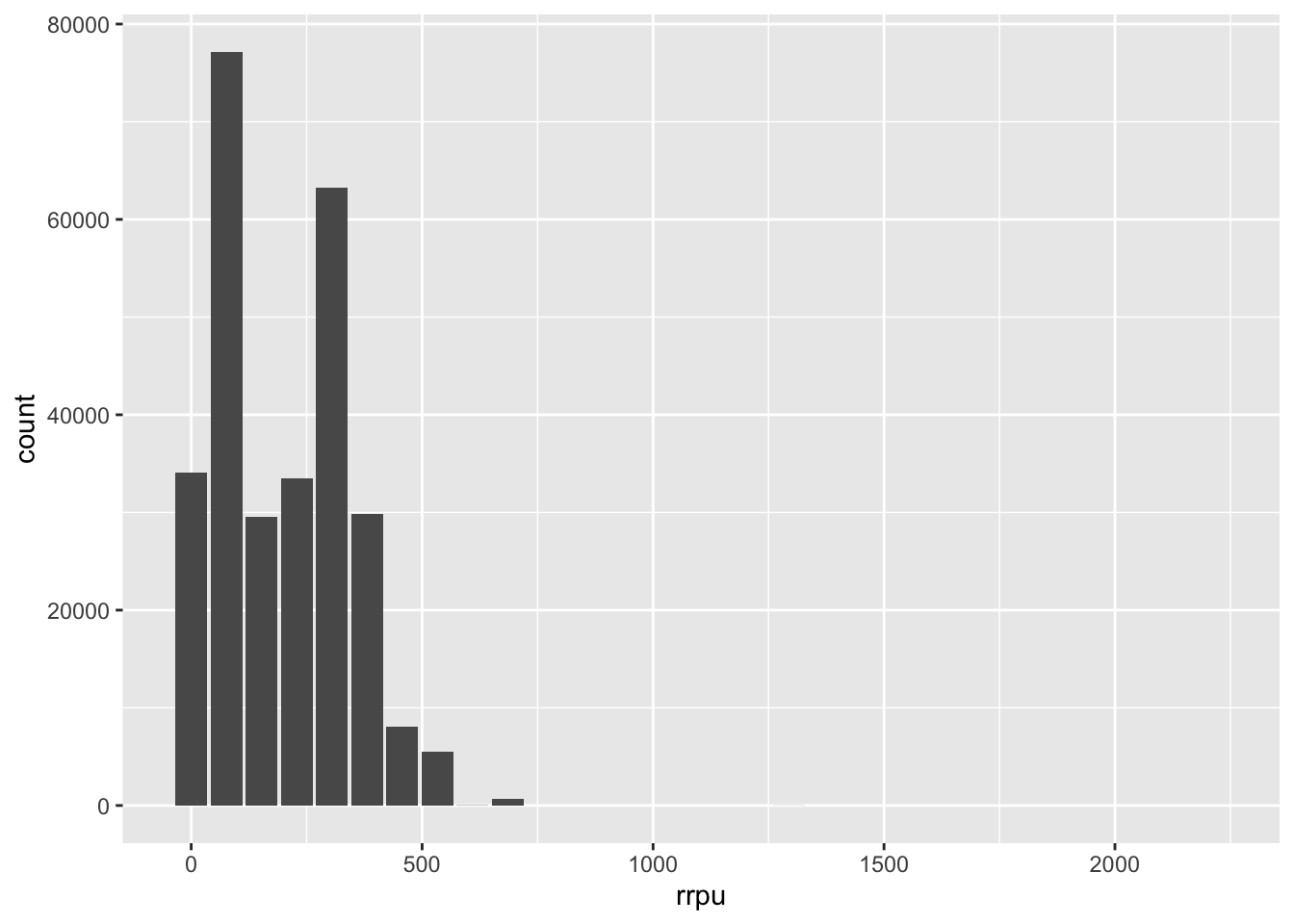Chapter 7 Advanced data manipulation
7.1 Agenda
- Base R
- Functions
- Iterations
- Advanced dplyr
7.2 Functions
We know functions from before:
mean()
7.3 Functions are automation
generate_report()train_model()write_xlsx_tables()create_ppt()
7.4 When should we write a function?
The automation rule
- Consider writing a function whenever you’ve copied and pasted a block of code more than twice.
7.5 Introduction to base R
- The native languange of R
dplyror other packages aredialects
7.5.1 selecting cols
With dplyr:
With base R - Brackets [] on data.frame
7.5.2 Filter and select
## hp mpg qsec
## 1 110 21.0 16.46
## 2 110 21.0 17.02
## 3 110 21.4 19.44
## 4 175 18.7 17.02
## 5 105 18.1 20.22
## 6 245 14.3 15.84
## 7 123 19.2 18.30
## 8 123 17.8 18.90
## 9 180 16.4 17.40
## 10 180 17.3 17.60
## 11 180 15.2 18.00
## 12 205 10.4 17.98
## 13 215 10.4 17.82
## 14 230 14.7 17.42
## 15 150 15.5 16.87
## 16 150 15.2 17.30
## 17 245 13.3 15.41
## 18 175 19.2 17.05
## 19 113 30.4 16.90
## 20 264 15.8 14.50
## 21 175 19.7 15.50
## 22 335 15.0 14.60
## 23 109 21.4 18.60With base R
## hp mpg qsec
## Mazda RX4 110 21.0 16.46
## Mazda RX4 Wag 110 21.0 17.02
## Hornet 4 Drive 110 21.4 19.44
## Hornet Sportabout 175 18.7 17.02
## Valiant 105 18.1 20.22
## Duster 360 245 14.3 15.84
## Merc 280 123 19.2 18.30
## Merc 280C 123 17.8 18.90
## Merc 450SE 180 16.4 17.40
## Merc 450SL 180 17.3 17.60
## Merc 450SLC 180 15.2 18.00
## Cadillac Fleetwood 205 10.4 17.98
## Lincoln Continental 215 10.4 17.82
## Chrysler Imperial 230 14.7 17.42
## Dodge Challenger 150 15.5 16.87
## AMC Javelin 150 15.2 17.30
## Camaro Z28 245 13.3 15.41
## Pontiac Firebird 175 19.2 17.05
## Lotus Europa 113 30.4 16.90
## Ford Pantera L 264 15.8 14.50
## Ferrari Dino 175 19.7 15.50
## Maserati Bora 335 15.0 14.60
## Volvo 142E 109 21.4 18.607.6 The syntax of package data.table
##
## Attaching package: 'data.table'## The following objects are masked from 'package:lubridate':
##
## hour, isoweek, mday, minute, month, quarter, second, wday,
## week, yday, year## The following objects are masked from 'package:dplyr':
##
## between, first, last## The following object is masked from 'package:purrr':
##
## transpose## hp mpg qsec
## 1: 110 21.0 16.46
## 2: 110 21.0 17.02
## 3: 110 21.4 19.44
## 4: 175 18.7 17.02
## 5: 105 18.1 20.22
## 6: 245 14.3 15.84
## 7: 123 19.2 18.30
## 8: 123 17.8 18.90
## 9: 180 16.4 17.40
## 10: 180 17.3 17.60
## 11: 180 15.2 18.00
## 12: 205 10.4 17.98
## 13: 215 10.4 17.82
## 14: 230 14.7 17.42
## 15: 150 15.5 16.87
## 16: 150 15.2 17.30
## 17: 245 13.3 15.41
## 18: 175 19.2 17.05
## 19: 113 30.4 16.90
## 20: 264 15.8 14.50
## 21: 175 19.7 15.50
## 22: 335 15.0 14.60
## 23: 109 21.4 18.60
## hp mpg qsecPackage
dtplyrcan be used to writedplyr-code that uses data.table at the back endGreat comparison of data.table and dplyr: https://atrebas.github.io/post/2019-03-03-datatable-dplyr/#select-columns
7.7 Double brackets
## [1] 6 6 4 6 8 6 8 4 4 6 6 8 8 8 8 8 8 4 4 4 4 8 8 8 8 4 4 4 8 6 8 4## [1] 87.8 Manipulating columns
## mpg cyl disp hp drat wt qsec vs am gear carb div
## 1 21.0 6 160.0 110 3.90 2.620 16.46 0 1 4 4 0.7838095
## 2 21.0 6 160.0 110 3.90 2.875 17.02 0 1 4 4 0.8104762
## 3 22.8 4 108.0 93 3.85 2.320 18.61 1 1 4 1 0.8162281
## 4 21.4 6 258.0 110 3.08 3.215 19.44 1 0 3 1 0.9084112
## 5 18.7 8 360.0 175 3.15 3.440 17.02 0 0 3 2 0.9101604
## 6 18.1 6 225.0 105 2.76 3.460 20.22 1 0 3 1 1.1171271
## 7 14.3 8 360.0 245 3.21 3.570 15.84 0 0 3 4 1.1076923
## 8 24.4 4 146.7 62 3.69 3.190 20.00 1 0 4 2 0.8196721
## 9 22.8 4 140.8 95 3.92 3.150 22.90 1 0 4 2 1.0043860
## 10 19.2 6 167.6 123 3.92 3.440 18.30 1 0 4 4 0.9531250
## 11 17.8 6 167.6 123 3.92 3.440 18.90 1 0 4 4 1.0617978
## 12 16.4 8 275.8 180 3.07 4.070 17.40 0 0 3 3 1.0609756
## 13 17.3 8 275.8 180 3.07 3.730 17.60 0 0 3 3 1.0173410
## 14 15.2 8 275.8 180 3.07 3.780 18.00 0 0 3 3 1.1842105
## 15 10.4 8 472.0 205 2.93 5.250 17.98 0 0 3 4 1.7288462
## 16 10.4 8 460.0 215 3.00 5.424 17.82 0 0 3 4 1.7134615
## 17 14.7 8 440.0 230 3.23 5.345 17.42 0 0 3 4 1.1850340
## 18 32.4 4 78.7 66 4.08 2.200 19.47 1 1 4 1 0.6009259
## 19 30.4 4 75.7 52 4.93 1.615 18.52 1 1 4 2 0.6092105
## 20 33.9 4 71.1 65 4.22 1.835 19.90 1 1 4 1 0.5870206
## 21 21.5 4 120.1 97 3.70 2.465 20.01 1 0 3 1 0.9306977
## 22 15.5 8 318.0 150 2.76 3.520 16.87 0 0 3 2 1.0883871
## 23 15.2 8 304.0 150 3.15 3.435 17.30 0 0 3 2 1.1381579
## 24 13.3 8 350.0 245 3.73 3.840 15.41 0 0 3 4 1.1586466
## 25 19.2 8 400.0 175 3.08 3.845 17.05 0 0 3 2 0.8880208
## 26 27.3 4 79.0 66 4.08 1.935 18.90 1 1 4 1 0.6923077
## 27 26.0 4 120.3 91 4.43 2.140 16.70 0 1 5 2 0.6423077
## 28 30.4 4 95.1 113 3.77 1.513 16.90 1 1 5 2 0.5559211
## 29 15.8 8 351.0 264 4.22 3.170 14.50 0 1 5 4 0.9177215
## 30 19.7 6 145.0 175 3.62 2.770 15.50 0 1 5 6 0.7868020
## 31 15.0 8 301.0 335 3.54 3.570 14.60 0 1 5 8 0.9733333
## 32 21.4 4 121.0 109 4.11 2.780 18.60 1 1 4 2 0.8691589With base R
The idea is to treat everything as vectors
- A thorough guide to vectors: https://r4ds.had.co.nz/vectors.html
7.9 Functions
We know them such as
mean(),sd(),read_csv()and so onBut why do we need them?
Say that we want to rescale the data vol columns in our first data-set
## Parsed with column specification:
## cols(
## .default = col_double(),
## source_date = col_datetime(format = ""),
## ar_key = col_character(),
## cust_id = col_character(),
## pc_l3_pd_spec_nm = col_character(),
## cpe_type = col_character(),
## cpe_net_type_cmpt = col_character(),
## pc_priceplan_nm = col_character(),
## sc_l5_sales_cnl = col_character(),
## rt_fst_cstatus_act_dt = col_datetime(format = ""),
## rrpu_amt_used = col_character(),
## rcm1pu_amt_used = col_character()
## )## See spec(...) for full column specifications.df$tr_tot_data_vol_all_netw_1 <- (df$tr_tot_data_vol_all_netw_1 -
min(df$tr_tot_data_vol_all_netw_1, na.rm = TRUE)) /
(max(df$tr_tot_data_vol_all_netw_1, na.rm = TRUE) -
min(df$tr_tot_data_vol_all_netw_1, na.rm = TRUE))For every column…
df$tr_tot_data_vol_all_netw_1 <- (df$tr_tot_data_vol_all_netw_1 - min(df$tr_tot_data_vol_all_netw_1, na.rm = TRUE))/
(max(df$tr_tot_data_vol_all_netw_1, na.rm = TRUE) -
min(df$tr_tot_data_vol_all_netw_1, na.rm = TRUE))
df$tr_tot_data_vol_all_netw_2 <- (df$tr_tot_data_vol_all_netw_2 - min(df$tr_tot_data_vol_all_netw_2, na.rm = TRUE)) /
(max(df$tr_tot_data_vol_all_netw_2, na.rm = TRUE) -
min(df$tr_tot_data_vol_all_netw_2, na.rm = TRUE))
df$tr_tot_data_vol_all_netw_3 <- (df$tr_tot_data_vol_all_netw_3 - min(df$tr_tot_data_vol_all_netw_3, na.rm = TRUE)) /
(max(df$tr_tot_data_vol_all_netw_3, na.rm = TRUE) -
min(df$tr_tot_data_vol_all_netw_2, na.rm = TRUE)) And so on..
This is:
boring
great risk of making mistakes
look at the last row
7.9.1 What is a function?
## [1] 0.1556303 0.3010300 0.1556303 0.2385606Abstract this code into a function
(df$tr_tot_data_vol_all_netw_2 - min(df$tr_tot_data_vol_all_netw_2, na.rm = TRUE)) /
(max(df$tr_tot_data_vol_all_netw_2, na.rm = TRUE) - min(df$tr_tot_data_vol_all_netw_2, na.rm = TRUE))- What is the input? What should be the argument in our function?
- What class is the input?
7.10 Name your functions
- Use meaningful explanatory words such as
get_data()ortrim_string()
7.10.1 Excercise 1
- Create a function called
my_mean()that hasmean(x, na.rm = TRUE)as default - Create a vector with NA and use it on it
7.10.2 Excercise 2
- Create a function that scales a vector
- Use your function on the data-set
tele2-kunder.csv
7.11 Conditions in functions
- We know
if_else()
In functions:
name_of_function <- function(x){
if(x > 100) {
(log10(x + 1) / x) + 200
} else {
log10(x + 1) / x
}
}
name_of_function(c(5,1,5,2))## Warning in if (x > 100) {: the condition has length > 1 and only the first
## element will be used## [1] 0.1556303 0.3010300 0.1556303 0.23856067.11.1 Customize error messages
## Warning in if (x > 100) {: the condition has length > 1 and only the first
## element will be used## Error in x + 1: non-numeric argument to binary operatorname_of_function <- function(x){
if(class(x) != "numeric") {
stop("Please provide a numeric input")
} else {
log10(x + 1) / x
}
}
name_of_function(c("text", "that", "does", "nothing"))## Error in name_of_function(c("text", "that", "does", "nothing")): Please provide a numeric input7.11.2 Other useful conditional functions
- warning(“This is a warning”)
- message(“Please not that you have NA’s in data”)
- print(“Something you want to tell me”)
7.11.3 Excercise 3
- Write a function called
praisethat has a logical input:happythat can be eitherTRUEorFALSE - If
TRUEreturn an encouraging text withprint("some text") - If
FALSEan even more encouraging text withprint("some text") - Remember: to check if something is
TRUEuseisTRUE()notx == TRUE
## [1] "Get yourself together you lazy schmuck!"7.12 Writing functions in the tidyverse
library(dplyr)
library(ggplot2)
groupwise_rrpu_summary <- function(df, group){
{{df}} %>%#<<
group_by({{group}}) %>% #<<
summarise(mean_rrpu = mean(alloc_rrpu_amt, na.rm = T))
}
groupwise_rrpu_summary(df, cpe_type)## # A tibble: 6 x 2
## cpe_type mean_rrpu
## <chr> <dbl>
## 1 MOBILE PHONE/FEATURE PHONE 191.
## 2 MODEM 224.
## 3 SMARTPHONE 285.
## 4 TABLET 119.
## 5 USB MODEM 88.1
## 6 WLAN ROUTER 212.Use this on another group
## # A tibble: 21 x 2
## pc_priceplan_nm mean_rrpu
## <chr> <dbl>
## 1 Bredband 4G 155.
## 2 Bredband 4G Only 100 GB - 2018 175.
## 3 Bredband 4G Only 200 GB 319.
## 4 Bredband 4G Only 400 GB - 2018 258.
## 5 Fast pris 254.
## 6 Fast pris +EU 1 GB 177.
## 7 Fast pris +EU 15 GB 299.
## 8 Fast pris +EU 15 GB - 2018 284.
## 9 Fast pris +EU 3 GB - 2018 191.
## 10 Fast pris +EU 30 GB - 2018 324.
## # … with 11 more rows7.12.1 Excercise 4
- Manipulate the function below so that it generates a bar chart visualizing the summary statitics
Make sure the plot
- Flips the coord for visability
- Displays the groups in order
library(dplyr)
library(ggplot2)
groupwise_rrpu_summary <- function(df, group){
group_by({{df}}, {{group}}) %>% #<<
summarise(mean_rrpu = mean(alloc_rrpu_amt, na.rm = T))
}
groupwise_rrpu_summary(df, cpe_type)## # A tibble: 6 x 2
## cpe_type mean_rrpu
## <chr> <dbl>
## 1 MOBILE PHONE/FEATURE PHONE 191.
## 2 MODEM 224.
## 3 SMARTPHONE 285.
## 4 TABLET 119.
## 5 USB MODEM 88.1
## 6 WLAN ROUTER 212.7.13 Iterations
Mmkay, so we have abstracted our code into a function.
What if we want to use it multiple times?
We still have to copy and paste… 😢
7.14 Let’s iterate instead
First select and resave
## [1] 1.360898e-01 8.971089e-02 9.359347e-02 3.077906e+04 2.832935e+04
## [6] 2.544908e+04 3.005769e+04 3.137266e+04 2.514190e+04 2.579391e+04
## [11] 2.173664e+04 2.529900e+047.14.1 purrr
- A package for making iterations easier
- Usually more robust than
for loops
- Usually faster than
for loops(although this is not naturally the case)
purrr needs:
- A named list or named vector
- A function
library(purrr)
cols <- df %>%
select(contains("alloc")) %>%
colnames() %>%
set_names()
mean_col <- function(x){
mean(df[[x]], na.rm = T)
}## $alloc_rrpu_amt
## [1] 266.9398
##
## $alloc_rcm1pu_amt
## [1] 243.52077.15 map() returns a list
## [1] "list"7.15.1 Functions for returning other classes:
- map() makes a list.
- map_lgl() makes a logical vector.
- map_int() makes an integer vector.
- map_dbl() makes a double vector.
- map_chr() makes a character vector.
7.16 For data.frames
- map_df() returns a data.frame
- for example if you read in multiple
xlsx-sheetsmap_dfbinds these together and returns a data.frame
7.17 Excercise 3
We have a function that creates a distribution-plot
data_vol_plot <- function(x){
ggplot(df, aes_string(x = x)) +
geom_density() +
theme_minimal() +
labs(title = paste("Distribution of", x))
}## Warning: Removed 4 rows containing non-finite values (stat_density).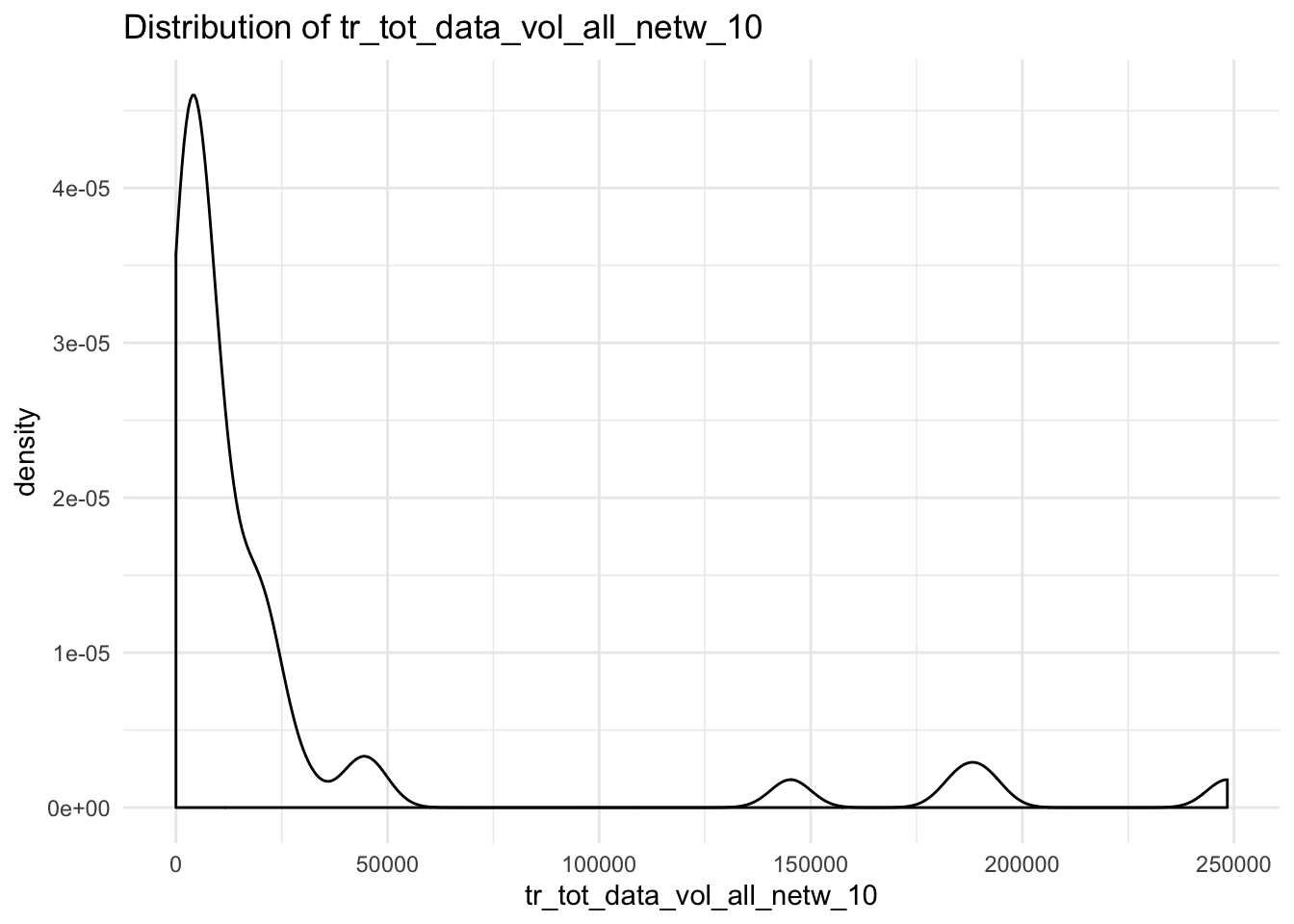
We want to iterate this function over all the data_vol-columns
Create a named vector with all the data_vol-columns
Apply the plot-function on every column
## $alloc_rrpu_amt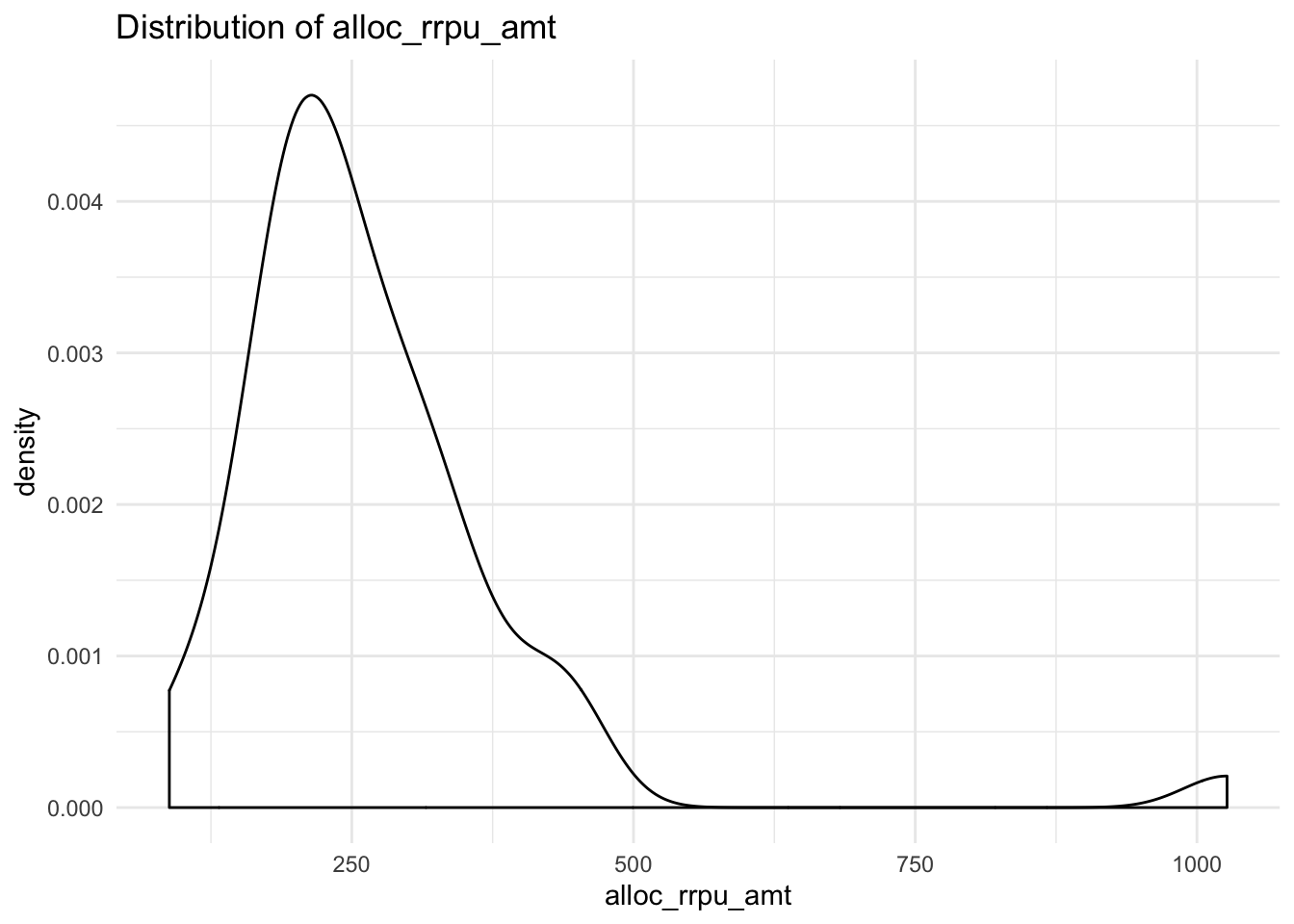
##
## $alloc_rcm1pu_amt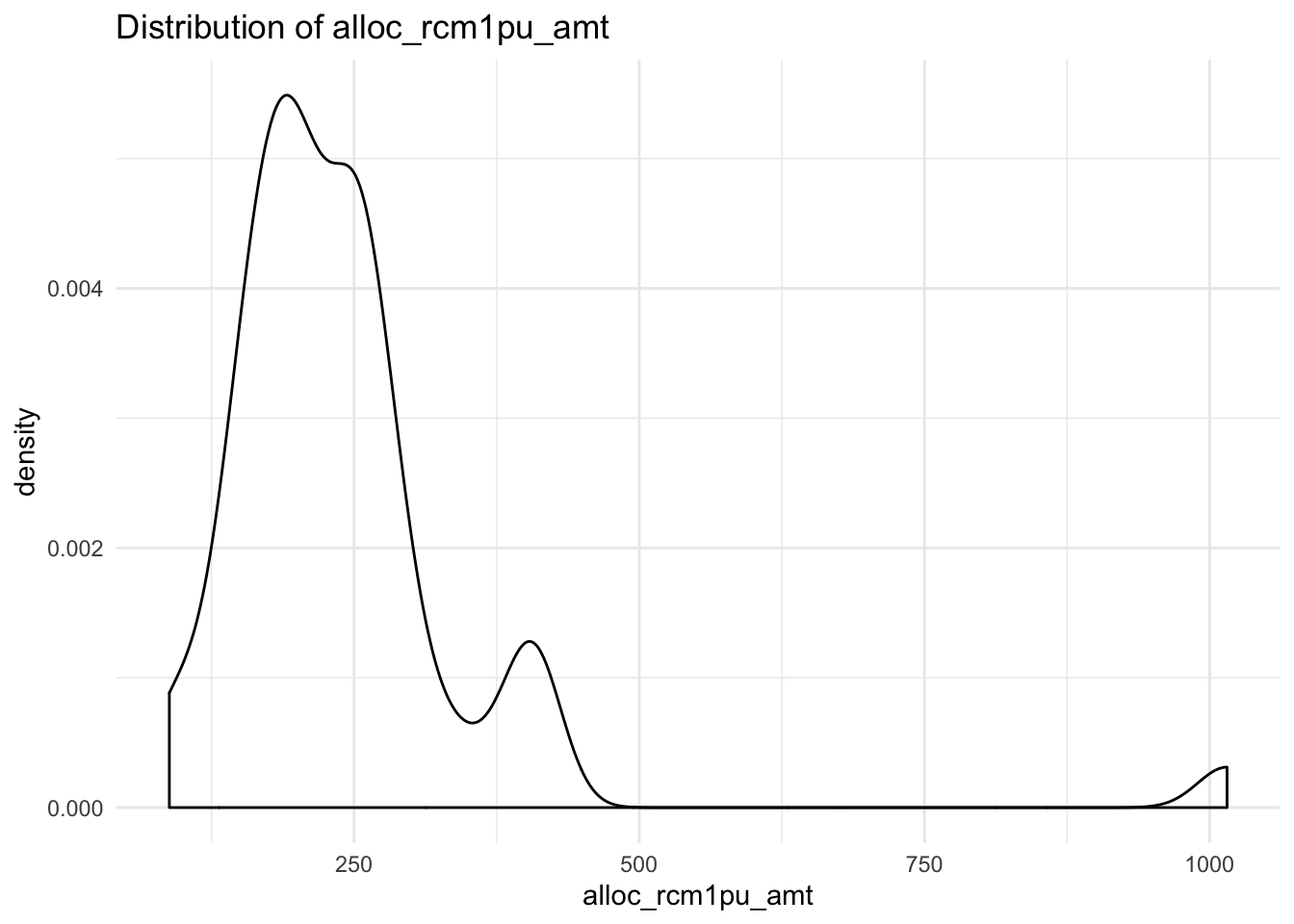
7.17.1 Use function to save plots
We can further manipulate the function to make it save the plots
data_vol_plot <- function(x){
if(!dir.exists("plots")){
dir.create("plots")
}
p <- ggplot(df, aes_string(x = x)) +
geom_density() +
theme_minimal() +
labs(title = paste("Distribution of", x))
ggsave(paste0("plots/", x, ".png"), p)
}
map(cols, data_vol_plot)## Saving 7 x 5 in image
## Saving 7 x 5 in image## $alloc_rrpu_amt
## NULL
##
## $alloc_rcm1pu_amt
## NULL7.18 Excercise 4
- Using this function:
data_vol_plot <- function(x){
if(!dir.exists("plots")){
dir.create("plots")
}
p <- ggplot(df, aes_string(x = x)) +
geom_density() +
theme_minimal() +
labs(title = paste("Distribution of", x))
ggsave(paste0("plots/", x, ".png"), p)
}- Save all the plots in a folder called
plotsusing the manipulated function
Like this:
7.18.1 purrr is powerful
Can be used for:
- Reading in complex
excel-workbooks - Creating many reports for different data-sets
- Applying many models on groups in data
7.19 Scoped verbs
- Sometimes we need want to do things such as calculate the mean of every numeric column
- For this we use
dplyr’s scoped verbs.
These are:
mutate_all()mutate_if()mutate_at()
These are the same for summarise()/select()/filter()/ arrange()
## column mean
## 1 mpg 20.0906250
## 2 cyl 6.1875000
## 3 disp 230.7218750
## 4 hp 146.6875000
## 5 drat 3.5965625
## 6 wt 3.2172500
## 7 qsec 17.8487500
## 8 vs 0.4375000
## 9 am 0.4062500
## 10 gear 3.6875000
## 11 carb 2.8125000
## 12 div 0.95691797.19.1 or mutating all columns
## mpg cyl disp hp drat wt qsec vs
## 1 1.322219 0.7781513 2.204120 2.041393 0.5910646 0.4183013 1.216430 -Inf
## 2 1.322219 0.7781513 2.204120 2.041393 0.5910646 0.4586378 1.230960 -Inf
## 3 1.357935 0.6020600 2.033424 1.968483 0.5854607 0.3654880 1.269746 0
## 4 1.330414 0.7781513 2.411620 2.041393 0.4885507 0.5071810 1.288696 0
## 5 1.271842 0.9030900 2.556303 2.243038 0.4983106 0.5365584 1.230960 -Inf
## 6 1.257679 0.7781513 2.352183 2.021189 0.4409091 0.5390761 1.305781 0
## 7 1.155336 0.9030900 2.556303 2.389166 0.5065050 0.5526682 1.199755 -Inf
## 8 1.387390 0.6020600 2.166430 1.792392 0.5670264 0.5037907 1.301030 0
## 9 1.357935 0.6020600 2.148603 1.977724 0.5932861 0.4983106 1.359835 0
## 10 1.283301 0.7781513 2.224274 2.089905 0.5932861 0.5365584 1.262451 0
## 11 1.250420 0.7781513 2.224274 2.089905 0.5932861 0.5365584 1.276462 0
## 12 1.214844 0.9030900 2.440594 2.255273 0.4871384 0.6095944 1.240549 -Inf
## 13 1.238046 0.9030900 2.440594 2.255273 0.4871384 0.5717088 1.245513 -Inf
## 14 1.181844 0.9030900 2.440594 2.255273 0.4871384 0.5774918 1.255273 -Inf
## 15 1.017033 0.9030900 2.673942 2.311754 0.4668676 0.7201593 1.254790 -Inf
## 16 1.017033 0.9030900 2.662758 2.332438 0.4771213 0.7343197 1.250908 -Inf
## 17 1.167317 0.9030900 2.643453 2.361728 0.5092025 0.7279477 1.241048 -Inf
## 18 1.510545 0.6020600 1.895975 1.819544 0.6106602 0.3424227 1.289366 0
## 19 1.482874 0.6020600 1.879096 1.716003 0.6928469 0.2081725 1.267641 0
## 20 1.530200 0.6020600 1.851870 1.812913 0.6253125 0.2636361 1.298853 0
## 21 1.332438 0.6020600 2.079543 1.986772 0.5682017 0.3918169 1.301247 0
## 22 1.190332 0.9030900 2.502427 2.176091 0.4409091 0.5465427 1.227115 -Inf
## 23 1.181844 0.9030900 2.482874 2.176091 0.4983106 0.5359267 1.238046 -Inf
## 24 1.123852 0.9030900 2.544068 2.389166 0.5717088 0.5843312 1.187803 -Inf
## 25 1.283301 0.9030900 2.602060 2.243038 0.4885507 0.5848963 1.231724 -Inf
## 26 1.436163 0.6020600 1.897627 1.819544 0.6106602 0.2866810 1.276462 0
## 27 1.414973 0.6020600 2.080266 1.959041 0.6464037 0.3304138 1.222716 -Inf
## 28 1.482874 0.6020600 1.978181 2.053078 0.5763414 0.1798389 1.227887 0
## 29 1.198657 0.9030900 2.545307 2.421604 0.6253125 0.5010593 1.161368 -Inf
## 30 1.294466 0.7781513 2.161368 2.243038 0.5587086 0.4424798 1.190332 -Inf
## 31 1.176091 0.9030900 2.478566 2.525045 0.5490033 0.5526682 1.164353 -Inf
## 32 1.330414 0.6020600 2.082785 2.037426 0.6138418 0.4440448 1.269513 0
## am gear carb div
## 1 0 0.6020600 0.6020600 -0.105789464
## 2 0 0.6020600 0.6020600 -0.091259739
## 3 0 0.6020600 0.0000000 -0.088188474
## 4 -Inf 0.4771213 0.0000000 -0.041717513
## 5 -Inf 0.4771213 0.3010300 -0.040882051
## 6 -Inf 0.4771213 0.0000000 0.048102576
## 7 -Inf 0.4771213 0.6020600 0.044419140
## 8 -Inf 0.6020600 0.3010300 -0.086359831
## 9 -Inf 0.6020600 0.3010300 0.001900635
## 10 -Inf 0.6020600 0.6020600 -0.020850139
## 11 -Inf 0.6020600 0.6020600 0.026041802
## 12 -Inf 0.4771213 0.4771213 0.025705400
## 13 -Inf 0.4771213 0.4771213 0.007466565
## 14 -Inf 0.4771213 0.4771213 0.073428917
## 15 -Inf 0.4771213 0.6020600 0.237756348
## 16 -Inf 0.4771213 0.6020600 0.233874360
## 17 -Inf 0.4771213 0.6020600 0.073730816
## 18 0 0.6020600 0.0000000 -0.221179059
## 19 0 0.6020600 0.3010300 -0.215232601
## 20 0 0.6020600 0.0000000 -0.231346622
## 21 -Inf 0.4771213 0.0000000 -0.031191371
## 22 -Inf 0.4771213 0.3010300 0.036783384
## 23 -Inf 0.4771213 0.3010300 0.056202515
## 24 -Inf 0.4771213 0.6020600 0.063950998
## 25 -Inf 0.4771213 0.3010300 -0.051576845
## 26 0 0.6020600 0.0000000 -0.159700843
## 27 0 0.6989700 0.3010300 -0.192256877
## 28 0 0.6989700 0.3010300 -0.254986879
## 29 0 0.6989700 0.6020600 -0.037289085
## 30 0 0.6989700 0.7781513 -0.104134528
## 31 0 0.6989700 0.9030900 -0.011738403
## 32 0 0.6020600 0.3010300 -0.060900829## mpg_min cyl_min disp_min hp_min drat_min wt_min qsec_min vs_min am_min
## 1 10.4 4 71.1 52 2.76 1.513 14.5 0 0
## gear_min carb_min div_min mpg_max cyl_max disp_max hp_max drat_max
## 1 3 1 0.5559211 33.9 8 472 335 4.93
## wt_max qsec_max vs_max am_max gear_max carb_max div_max
## 1 5.424 22.9 1 1 5 8 1.728846mtcars %>%
summarise_all(list(~min(.), ~max(.))) %>%
gather(colname, value) %>%
separate(colname, into = c("colname", "calc"), sep = "_")## colname calc value
## 1 mpg min 10.4000000
## 2 cyl min 4.0000000
## 3 disp min 71.1000000
## 4 hp min 52.0000000
## 5 drat min 2.7600000
## 6 wt min 1.5130000
## 7 qsec min 14.5000000
## 8 vs min 0.0000000
## 9 am min 0.0000000
## 10 gear min 3.0000000
## 11 carb min 1.0000000
## 12 div min 0.5559211
## 13 mpg max 33.9000000
## 14 cyl max 8.0000000
## 15 disp max 472.0000000
## 16 hp max 335.0000000
## 17 drat max 4.9300000
## 18 wt max 5.4240000
## 19 qsec max 22.9000000
## 20 vs max 1.0000000
## 21 am max 1.0000000
## 22 gear max 5.0000000
## 23 carb max 8.0000000
## 24 div max 1.7288462## mpg cyl disp hp drat wt qsec vs
## 1 20.09062 6.1875 230.7219 146.6875 3.596563 3.21725 17.84875 0.4375
## am gear carb div
## 1 0.40625 3.6875 2.8125 0.95691797.19.2 Excercise 5
- Calculate the mean on every numeric column in your data frame.
7.20 R and databases
Databases are great for storing data
Can do heavy computations on a lot of data
7.20.1 Different strategies



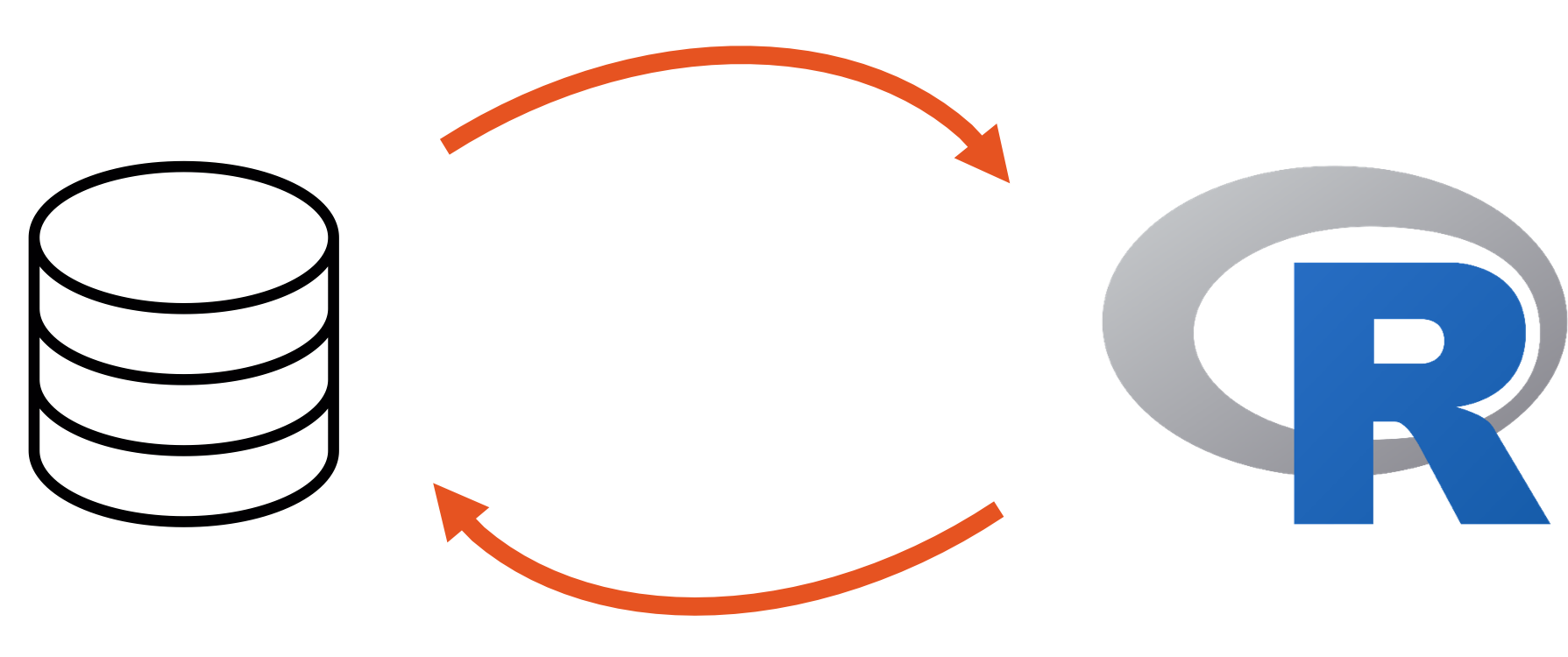
7.20.2 What databases need
Credentials
Location
Driver
For example:
Credentials - token/userame/network-config
Location - IP/URL
Driver - ODBC/JDBC
We will use Spark as a database
##
## Attaching package: 'sparklyr'## The following object is masked from 'package:purrr':
##
## invoke7.21 Copy data to data base
## # Source: spark<flights> [?? x 19]
## year month day dep_time sched_dep_time dep_delay arr_time
## <int> <int> <int> <int> <int> <dbl> <int>
## 1 2013 1 1 517 515 2 830
## 2 2013 1 1 533 529 4 850
## 3 2013 1 1 542 540 2 923
## 4 2013 1 1 544 545 -1 1004
## 5 2013 1 1 554 600 -6 812
## 6 2013 1 1 554 558 -4 740
## 7 2013 1 1 555 600 -5 913
## 8 2013 1 1 557 600 -3 709
## 9 2013 1 1 557 600 -3 838
## 10 2013 1 1 558 600 -2 753
## # … with more rows, and 12 more variables: sched_arr_time <int>,
## # arr_delay <dbl>, carrier <chr>, flight <int>, tailnum <chr>,
## # origin <chr>, dest <chr>, air_time <dbl>, distance <dbl>, hour <dbl>,
## # minute <dbl>, time_hour <dttm>7.22 Once data is in Spark you can use SQL with it
| origin | n |
|---|---|
| JFK | 111279 |
| LGA | 104662 |
| EWR | 120835 |
This follows this strategy

7.22.1 You can use dplyr with SQL as a backend
##
## Attaching package: 'dbplyr'## The following objects are masked from 'package:dplyr':
##
## ident, sql## # Source: spark<?> [?? x 2]
## # Groups: origin
## origin n
## <chr> <dbl>
## 1 JFK 111279
## 2 LGA 104662
## 3 EWR 1208357.22.2 And we can use dplyr’s scoped verbs in Spark
## Applying predicate on the first 100 rows## Warning: Missing values are always removed in SQL.
## Use `mean(x, na.rm = TRUE)` to silence this warning
## This warning is displayed only once per session.## # A tibble: 14 x 2
## colname mean
## <chr> <dbl>
## 1 year 2013
## 2 month 6.55
## 3 day 15.7
## 4 dep_time 1349.
## 5 sched_dep_time 1344.
## 6 dep_delay 12.6
## 7 arr_time 1502.
## 8 sched_arr_time 1536.
## 9 arr_delay 6.90
## 10 flight 1972.
## 11 air_time 151.
## 12 distance 1040.
## 13 hour 13.2
## 14 minute 26.27.22.3 We can also read csv-files into Spark using spark_read_csv(sc, name, path)
7.23 Excercise 5
Connect to your spark-cluster
read in the data-set
tele2-transaction.csvinto Spark usingspark_read_csv()Which is the most common “säljkanal”?
What’s the mean
rrpufor each priceplan?How many customers did increase their number of subscriptions when signing a new contract?
What is the most common
bas_bucket_size?
7.24 Manipulating spark data.frames
- A lot of functions in R are translated to SQL when you call them on a database-table
7.24.1 Basic math operators
+, -, *, /, %%, ^
7.24.2 Math functions
abs, acos, asin, asinh, atan, atan2, ceiling, cos, cosh, exp, floor, log, log10, round, sign, sin, sinh, sqrt, tan, tanh
7.24.3 Logical comparisons
<, <=, !=, >=, >, ==, %in%
7.24.4 Boolean operations
&, &&, |, ||, !
7.24.5 Character functions
paste, tolower, toupper, nchar
7.24.6 Casting
as.double, as.integer, as.logical, as.character, as.date
7.24.7 Basic aggregations
mean, sum, min, max, sd, var, cor, cov, n
7.25 This means we can call these functions in mutate() on a Spark data.frame
## # Source: spark<?> [?? x 6]
## year month day dep_time sched_dep_time carrier
## <int> <int> <int> <int> <int> <chr>
## 1 2013 1 1 517 515 ua
## 2 2013 1 1 533 529 ua
## 3 2013 1 1 542 540 aa
## 4 2013 1 1 544 545 b6
## 5 2013 1 1 554 600 dl
## 6 2013 1 1 554 558 ua
## 7 2013 1 1 555 600 b6
## 8 2013 1 1 557 600 ev
## 9 2013 1 1 557 600 b6
## 10 2013 1 1 558 600 aa
## # … with more rowsflights %>%
mutate(date = as.Date(paste(year,"-", month,"-", day))) %>%
select(year, month, day, date)## # Source: spark<?> [?? x 4]
## year month day date
## <int> <int> <int> <date>
## 1 2013 1 1 2013-01-01
## 2 2013 1 1 2013-01-01
## 3 2013 1 1 2013-01-01
## 4 2013 1 1 2013-01-01
## 5 2013 1 1 2013-01-01
## 6 2013 1 1 2013-01-01
## 7 2013 1 1 2013-01-01
## 8 2013 1 1 2013-01-01
## 9 2013 1 1 2013-01-01
## 10 2013 1 1 2013-01-01
## # … with more rows7.26 What dplyr does is just really translating the dplyr-code into SQL
flights %>%
mutate(date = as.Date(paste(year,"-", month,"-", day))) %>%
select(year, month, day, date) %>%
show_query()## <SQL>
## SELECT `year`, `month`, `day`, CAST(CONCAT_WS(" ", `year`, "-", `month`, "-", `day`) AS DATE) AS `date`
## FROM `flights`7.27 When do we need to bring data into R?
- Plotting
7.28 How do we collect data into R?
- with
collect()
flights %>%
group_by(origin) %>%
count() %>%
collect() %>%
ggplot(aes(x = reorder(origin, -n), y = n)) +
geom_col() +
theme_minimal() +
labs(title = "Number of flights / origin",
x = "Origin",
y = "Number of flights")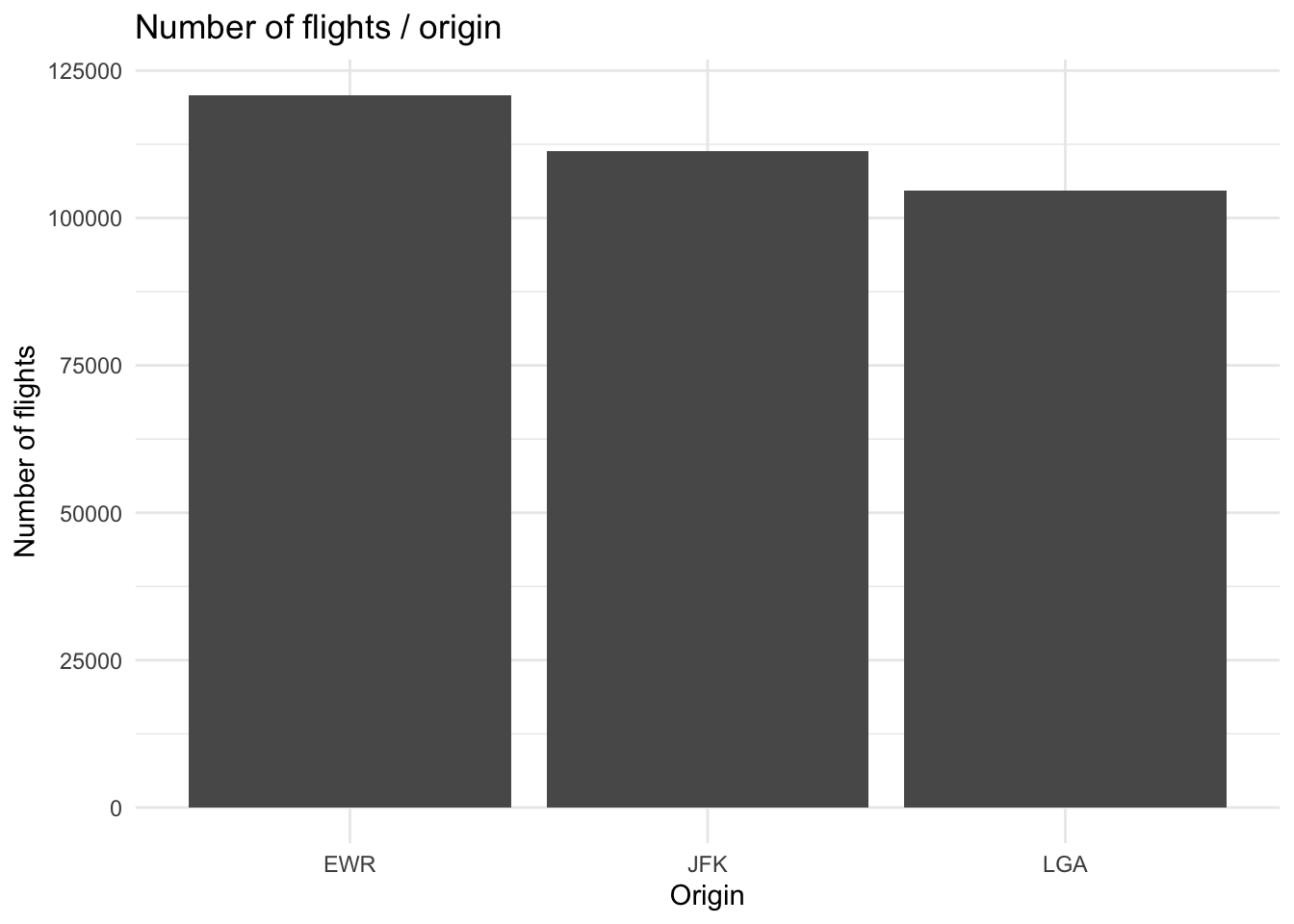
Or
flights %>%
mutate(date = as.Date(paste0(as.character(year), "-", as.character(month), "-", as.character(day)))) %>%
group_by(date, origin) %>%
count() %>%
collect() %>%
ggplot(aes(x = date, y = n, color = origin)) +
geom_point() +
geom_smooth() +
theme_minimal() +
labs(title = "Number of flights",
x = "Origin",
y = "Number of flights") +
scale_y_continuous(limits = c(0, 450))## `geom_smooth()` using method = 'loess' and formula 'y ~ x'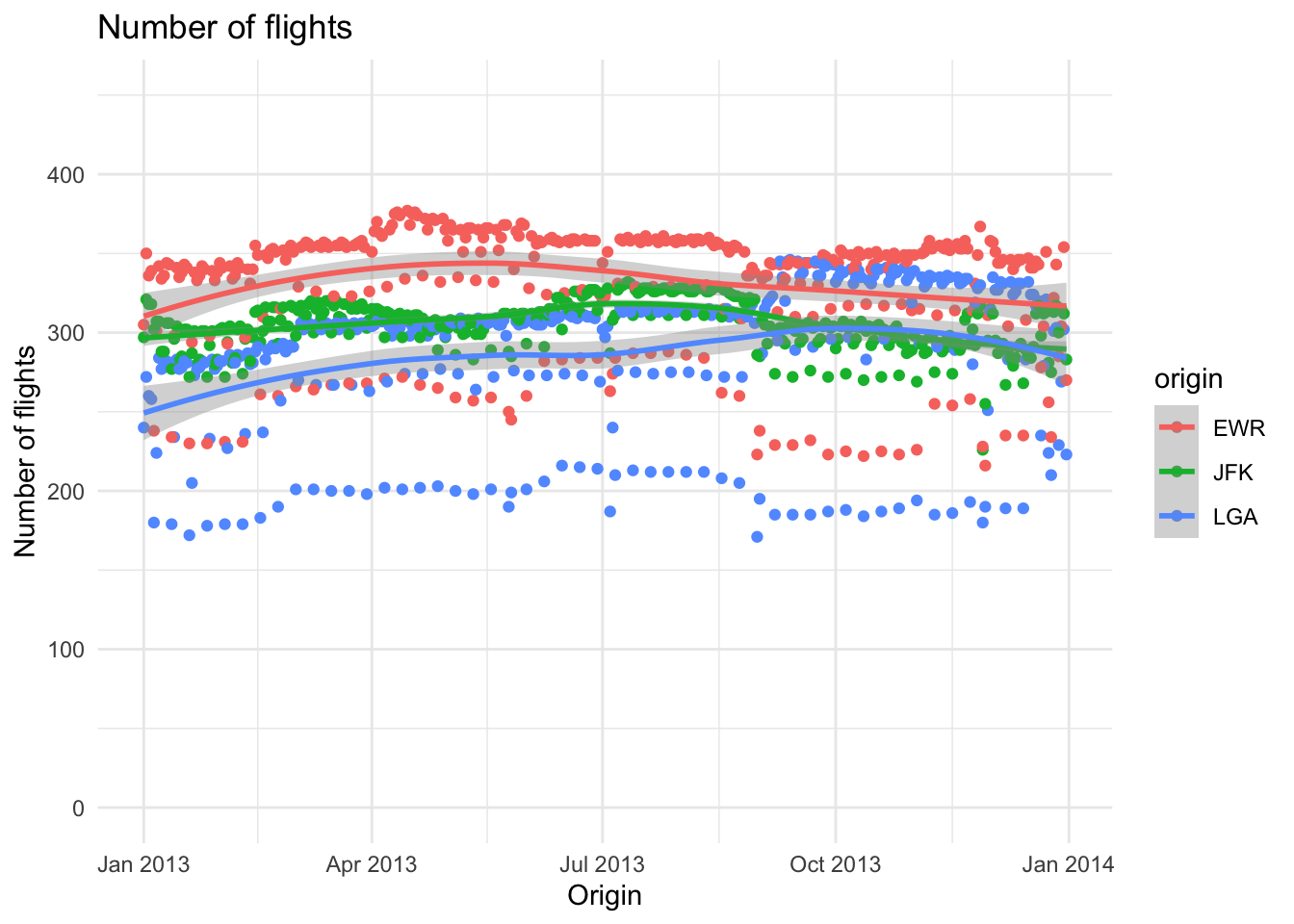
7.29 Visualize distributions in a database
- You can do this with the package
dbplot
## Warning: Removed 1 rows containing missing values (position_stack).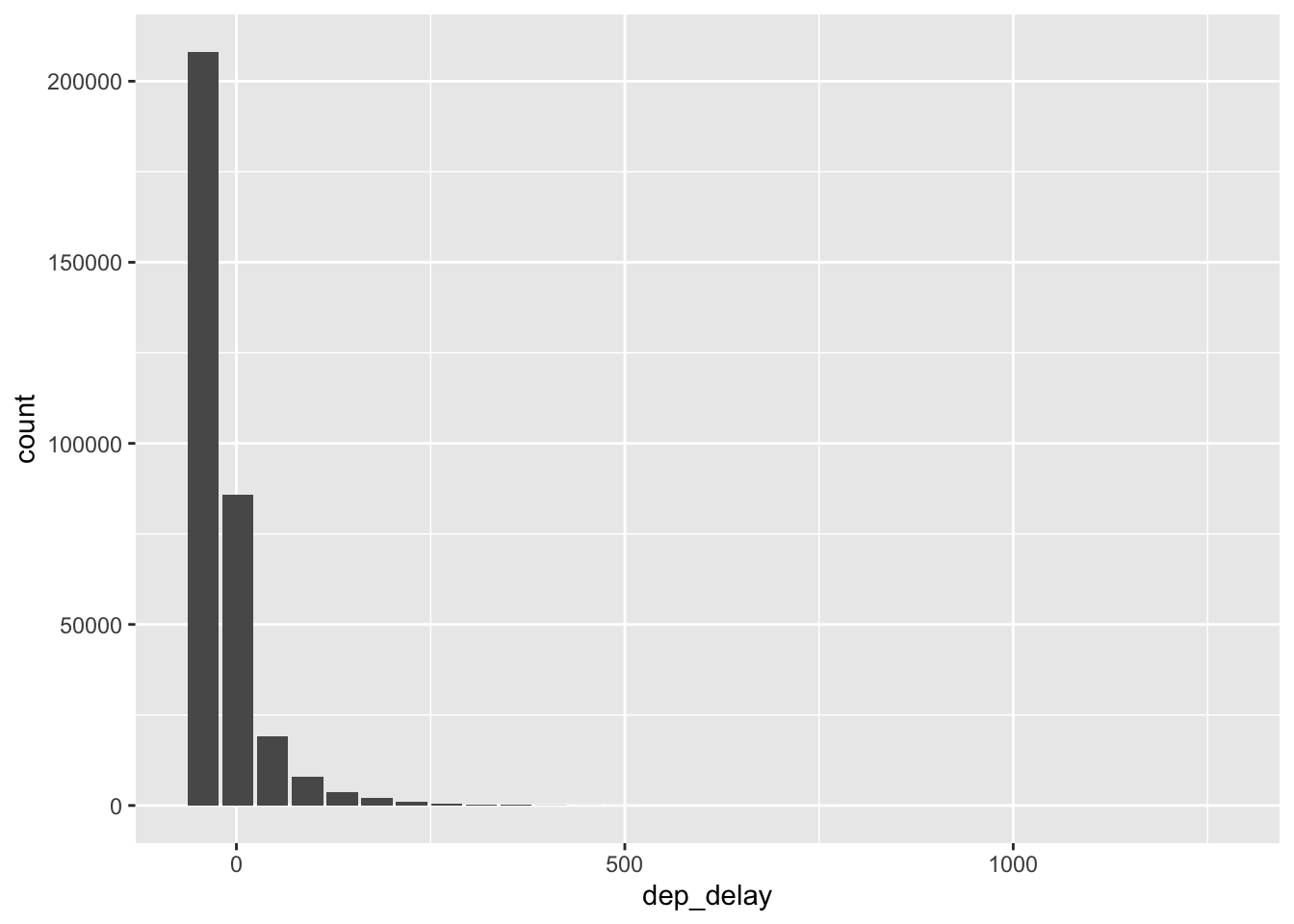
## Warning: Removed 30 rows containing missing values (geom_tile).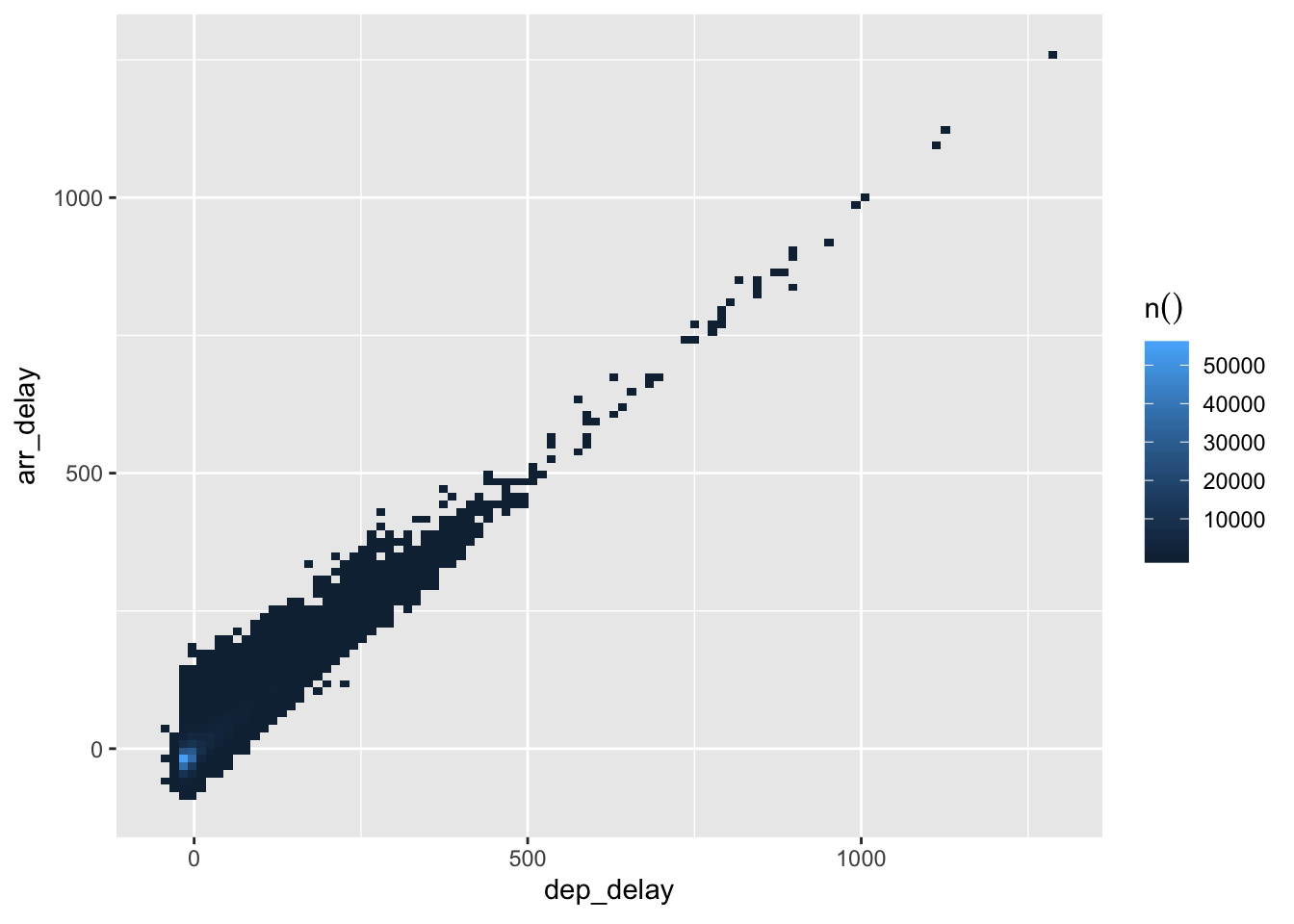
7.30 Excercise 6
Visualize subscriptions over time, either by day, or month or any other variable you find suitable
Which priceplan is most profitable? Visualize
What is the most common customer type? Visualize
Can you visualize any numerical relationships in the data?
7.31 Extra
- Explore the transactions data-set
- Make 4 visualizations that tells a story about this data-set
- If you have time, try out the package
flexdashboardand turn your four visualizations into a dashboard withsparklyras a backend. - I have set up a dashboard-file for you to continue with, you can download it here: https://github.com/Ferrologic/flexdashboard-tele2
7.32 Facit advanced data manipulations
7.32.1 Excercise 1
- Create a functions called
my_mean()that hasmean(x, na.rm = TRUE)as default - Create a vector with NA and use it on it
## [1] -0.14084287.32.2 Excercise 2
- Create a function that scales a vector
- Use your function on the data-set
tele2-kunder.csv
(df$tr_tot_data_vol_all_netw_2 -
min(df$tr_tot_data_vol_all_netw_2, na.rm = TRUE)) /
(max(df$tr_tot_data_vol_all_netw_2, na.rm = TRUE) -
min(df$tr_tot_data_vol_all_netw_2, na.rm = TRUE))scale_vector <- function(x){
(x -
min(x, na.rm = TRUE)) /
(max(x, na.rm = TRUE) -
min(x, na.rm = TRUE))
}
scale_vector(x)## [1] 0.48759965 0.07138241 0.31716348 0.46929592 0.32039189 0.15150801
## [7] 0.33335465 0.24057149 0.53296593 0.29368642 0.15274015 1.00000000
## [13] 0.28566758 0.61719235 0.28498834 0.49749998 0.54362853 0.43417857
## [19] 0.45108149 0.29380767 0.18845253 0.34592773 0.56154395 0.37484007
## [25] 0.11758121 0.44794172 0.81734750 0.32088468 0.18346424 0.28962714
## [31] 0.41973885 0.73729308 0.47884044 0.22707054 0.07897952 0.29641309
## [37] 0.22190696 0.72066895 0.00000000 0.43248430 0.32070481 0.02051455
## [43] 0.64354132 0.52026814 0.23037616 0.40923294 0.16434551 0.62762436
## [49] 0.01036543 0.43683015 0.20593791 0.09344743 0.30527104 0.05249077
## [55] 0.54582185 0.23478171 0.43035853 0.60224484 0.20462079 0.30158595
## [61] 0.45609084 0.02845019 0.23845682 0.36423597 0.62984197 0.40832348
## [67] 0.60718890 0.47947916 0.32906815 0.14540373 0.26220457 0.52006005
## [73] 0.43676457 0.17114527 0.47926092 0.35597789 0.62987377 0.63207230
## [79] 0.27355137 0.30428798 0.50476594 0.23095888 0.06911469 0.79081748
## [85] 0.81988563 0.29283427 0.16048760 0.44379826 0.17289093 0.52759973
## [91] 0.16751942 0.39802162 0.15513719 0.73383755 0.56431791 0.27799104
## [97] 0.13832932 0.54948085 0.19746301 0.21128377 NA NA
## [103] NA NA NA NA NA NA
## [109] NA NA7.32.3 Excercise 3
- Write a function called
praisethat has a logical input:happythat can be eitherTRUEorFALSE - If
TRUEreturn an encouraging text withprint("some text") - If
FALSEan even more encouraging text withprint("some text") - Remember: to check if something is
TRUEuseisTRUE()notx == TRUE
## [1] "Get yourself together you lazy schmuck!"7.32.4 Excercise 4
- Manipulate the function below so that it generates a bar chart visualizing the summary statitics
Make sure the plot
- Flips the coord for visability
- Displays the groups in order
library(dplyr)
library(ggplot2)
groupwise_rrpu_summary <- function(df, group){
group_by({{df}}, {{group}}) %>% #<<
summarise(mean_rrpu = mean(alloc_rrpu_amt, na.rm = T)) %>%
ggplot(aes(x = reorder({{group}}, mean_rrpu), y = mean_rrpu)) +
geom_col() +
theme_minimal()
}
groupwise_rrpu_summary(df, cpe_type) +
coord_flip()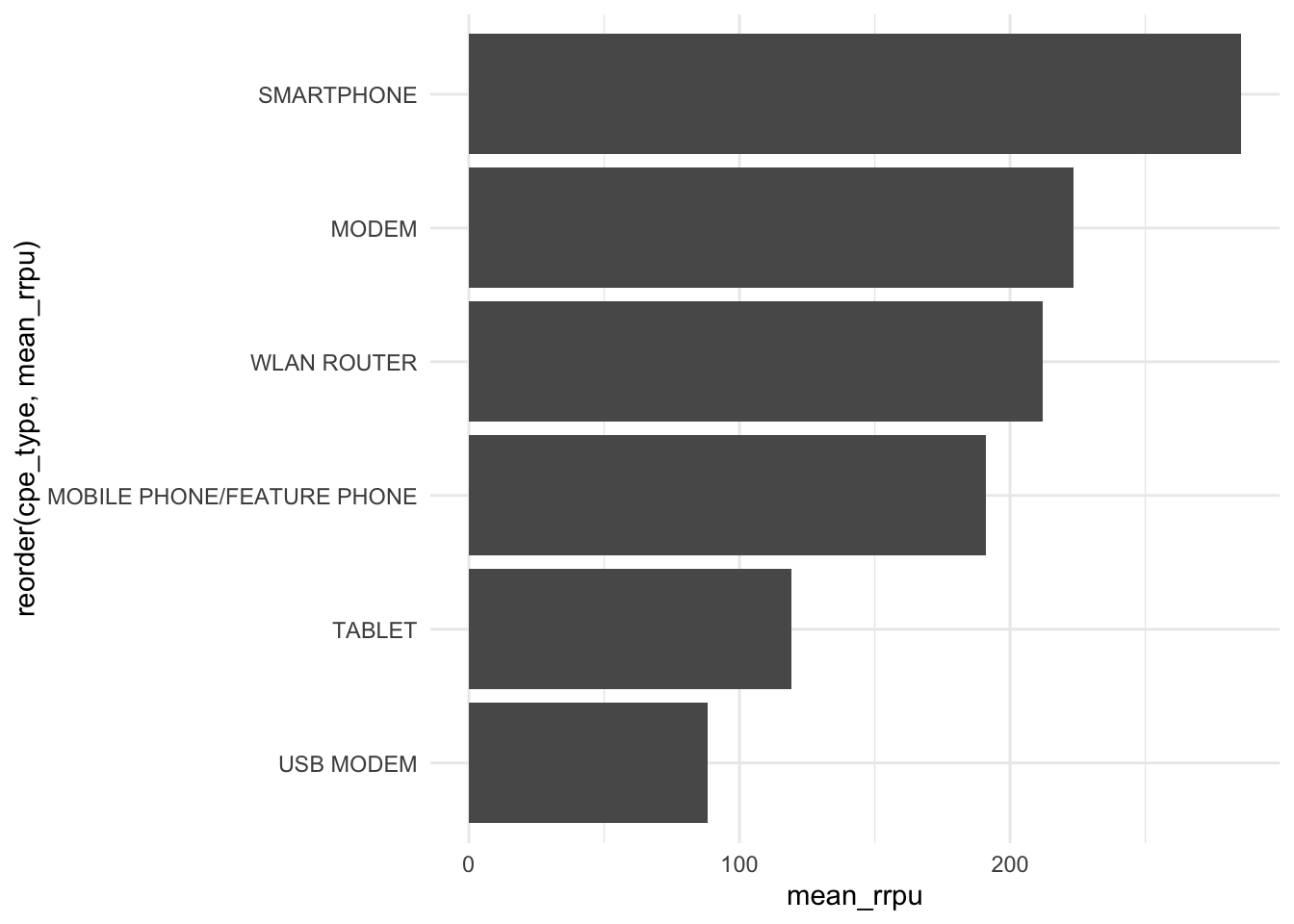
7.32.5 Excercise 3
We want to iterate this function over all the data_vol-columns
- Create a named vector with all the data_vol-columns, use
colnames()
- Apply the plot-function on every column
data_vol_plot <- function(x){
ggplot(df, aes_string(x = x)) +
geom_density() +
theme_minimal() +
labs(title = paste("Distribution of", x))
}
map(cols, data_vol_plot)## $tr_tot_data_vol_all_netw_1## Warning: Removed 3 rows containing non-finite values (stat_density).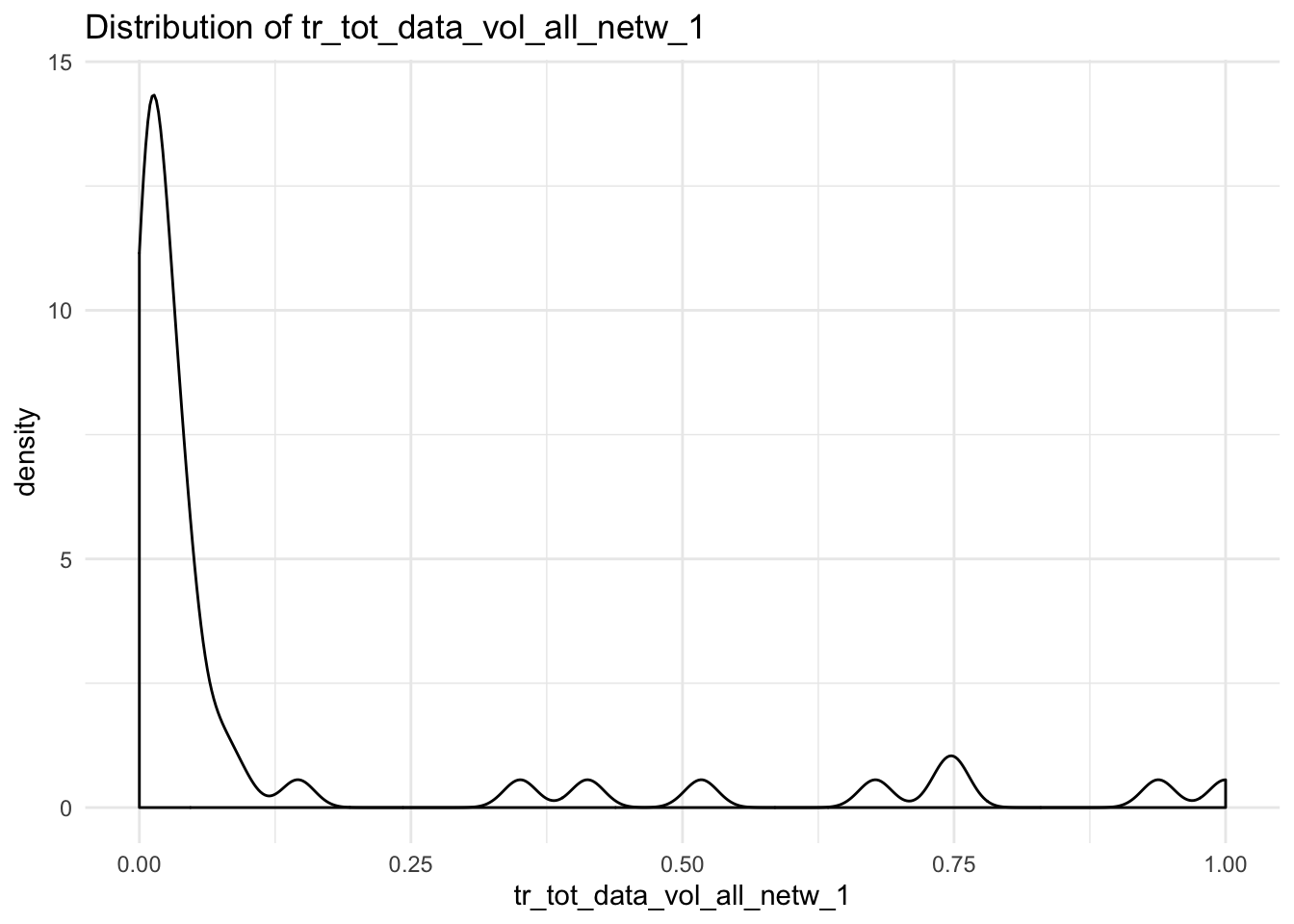
##
## $tr_tot_data_vol_all_netw_2## Warning: Removed 3 rows containing non-finite values (stat_density).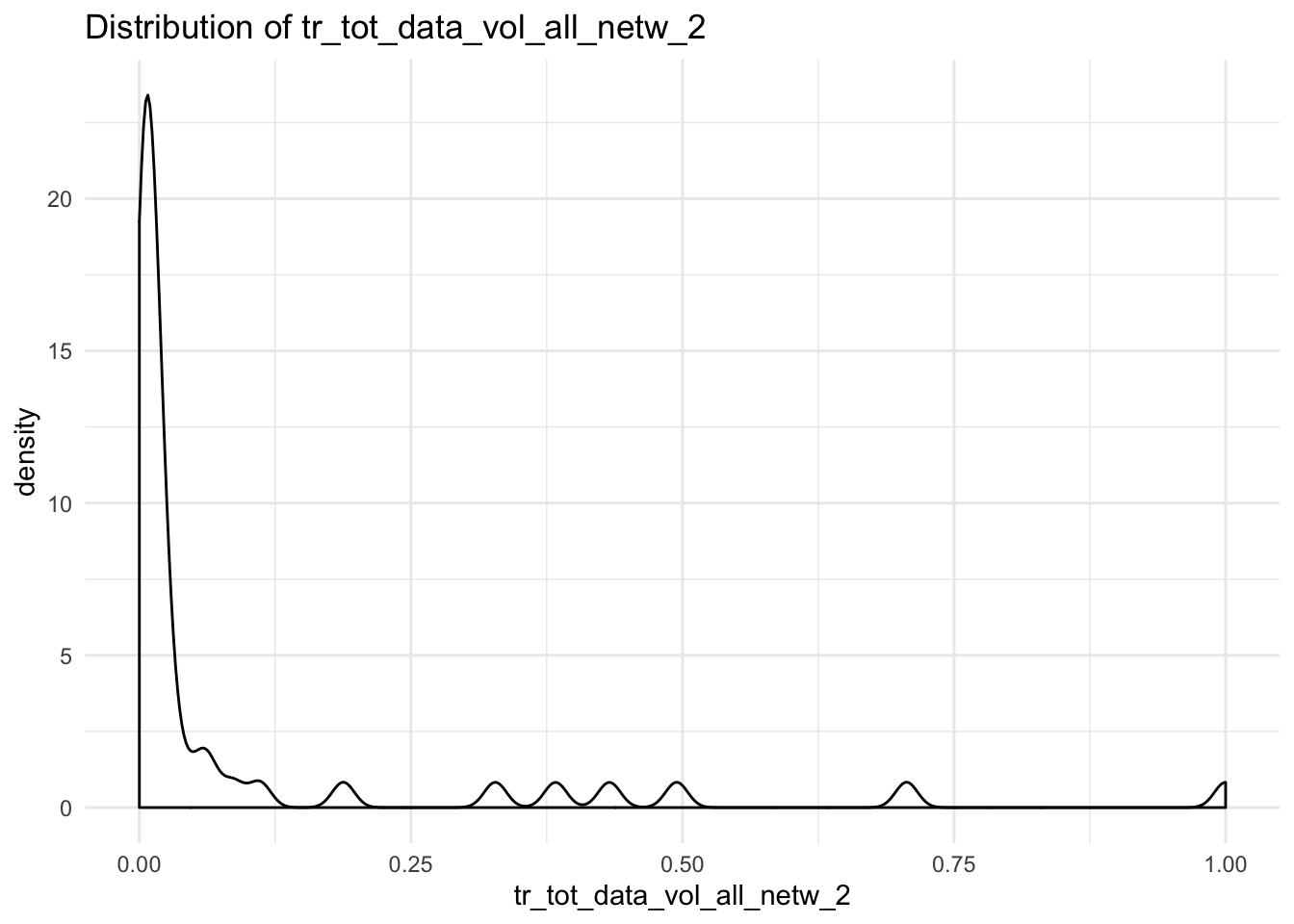
##
## $tr_tot_data_vol_all_netw_3## Warning: Removed 1 rows containing non-finite values (stat_density).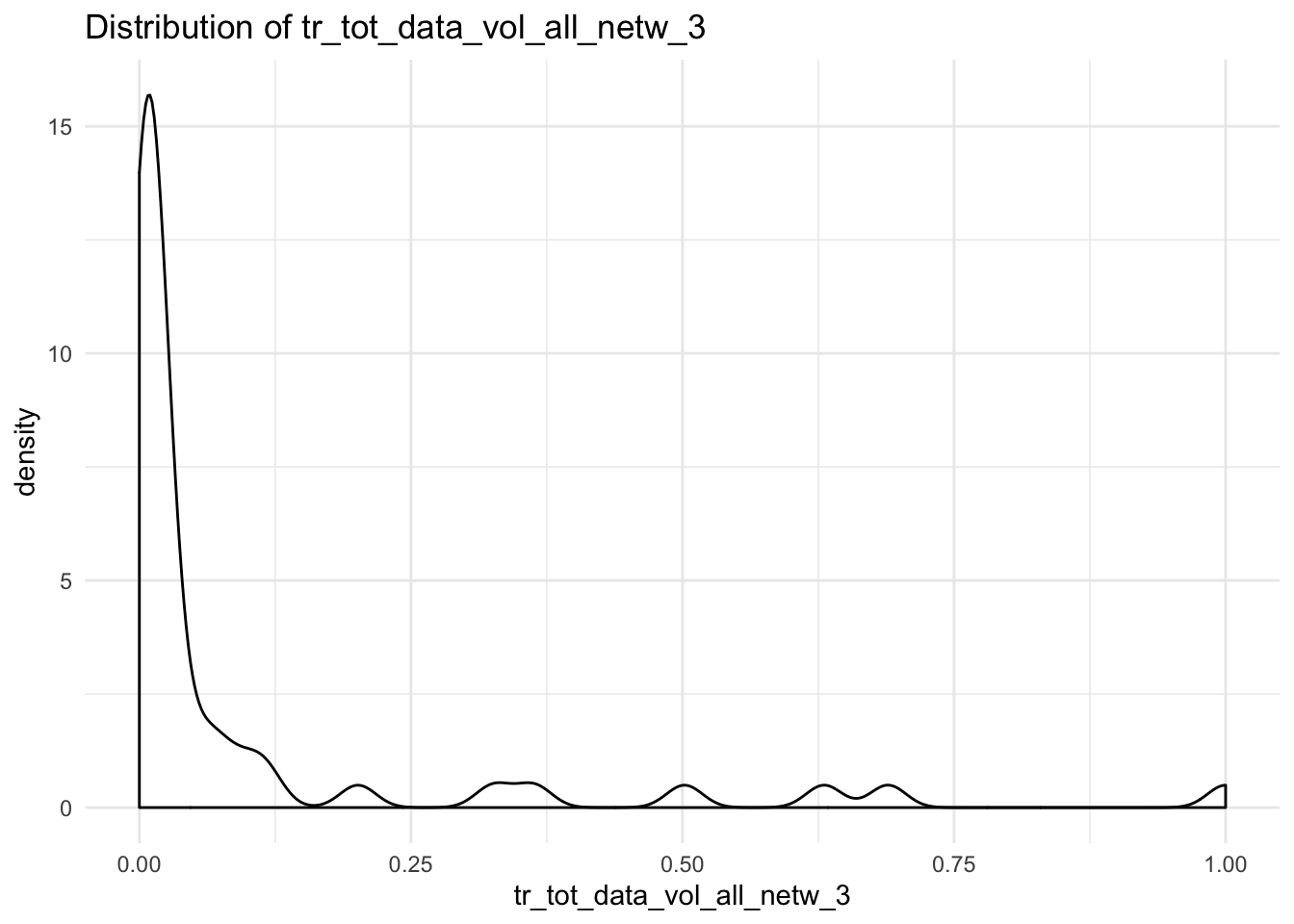
##
## $tr_tot_data_vol_all_netw_4## Warning: Removed 3 rows containing non-finite values (stat_density).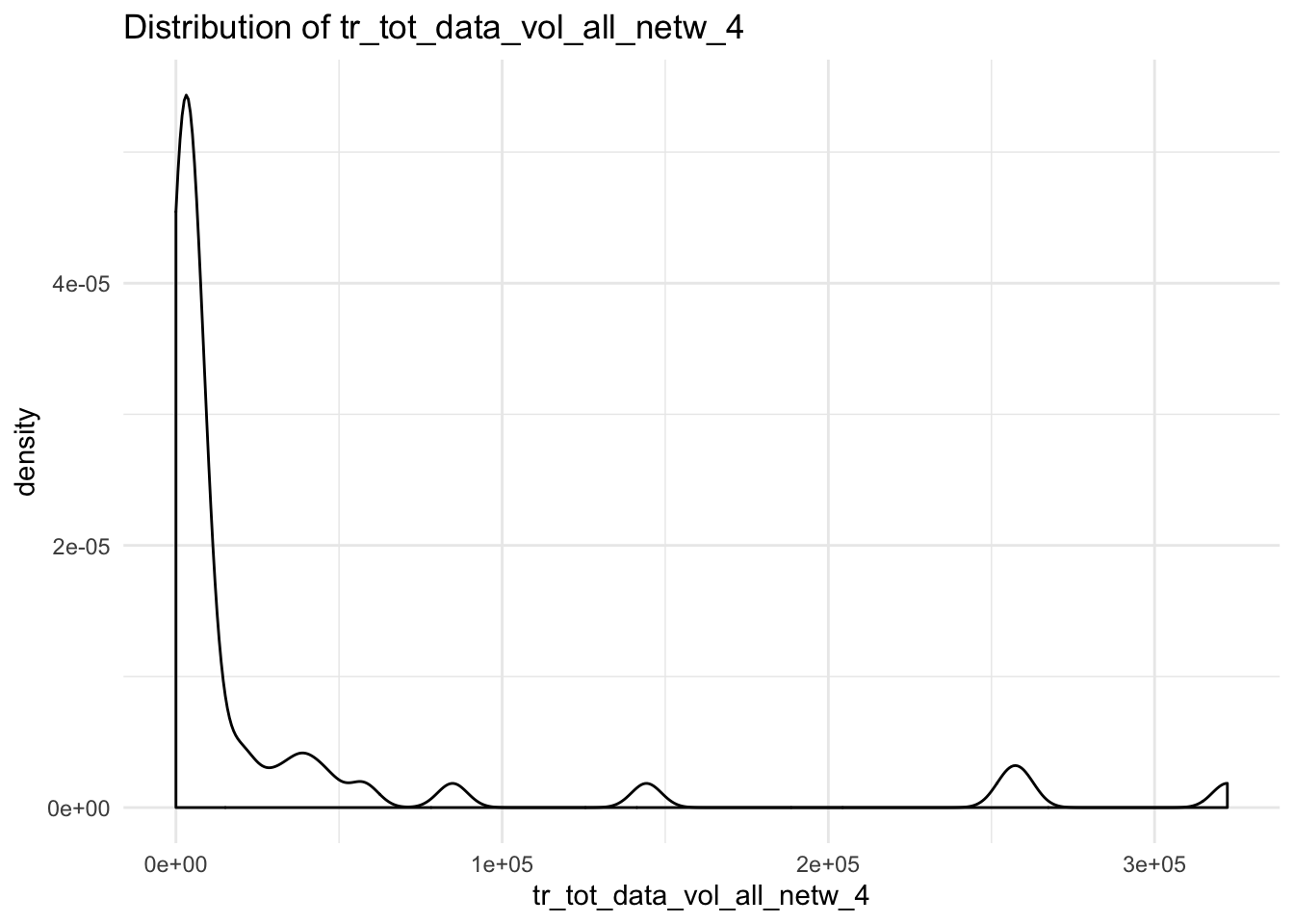
##
## $tr_tot_data_vol_all_netw_5## Warning: Removed 4 rows containing non-finite values (stat_density).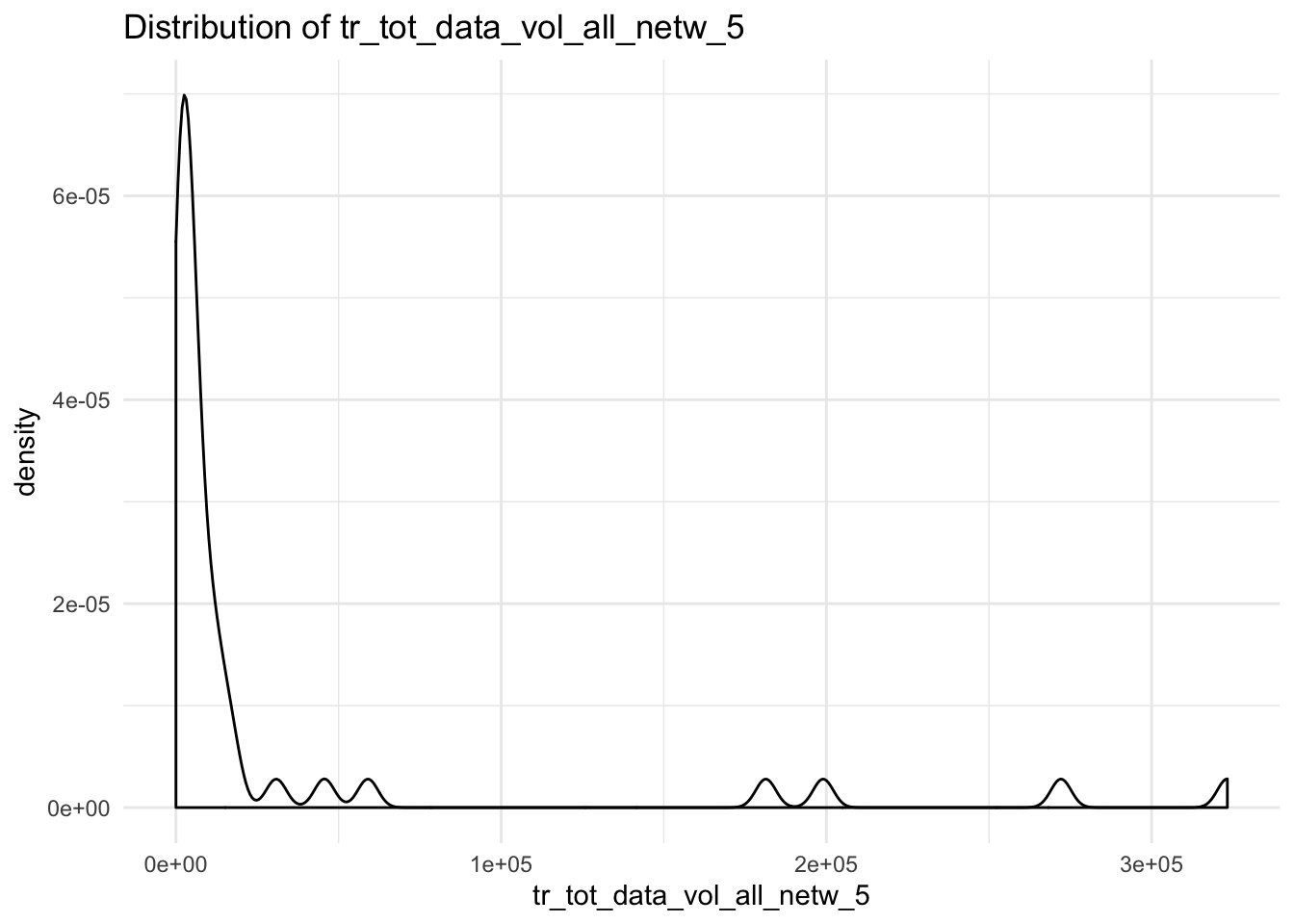
##
## $tr_tot_data_vol_all_netw_6## Warning: Removed 4 rows containing non-finite values (stat_density).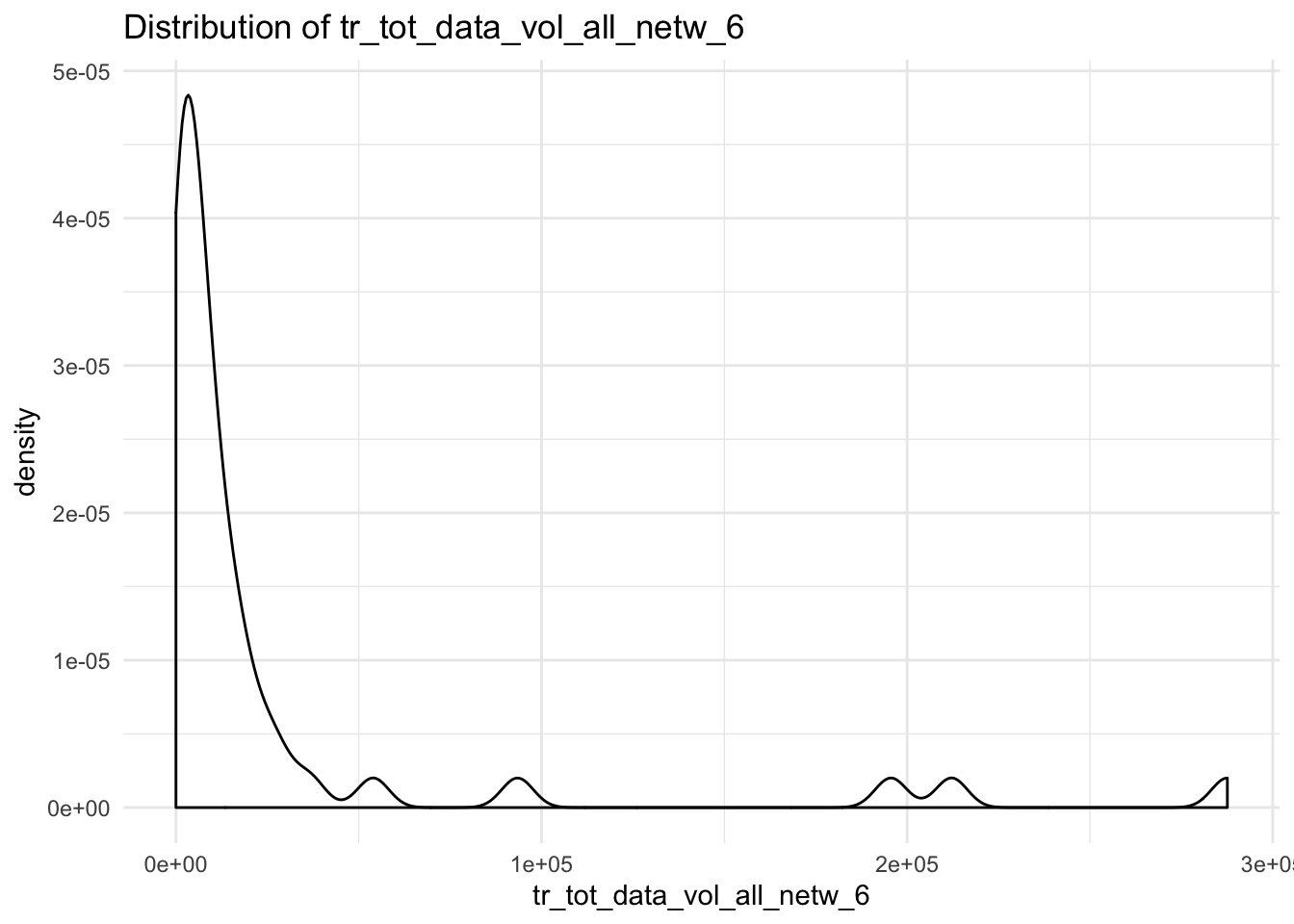
##
## $tr_tot_data_vol_all_netw_7## Warning: Removed 4 rows containing non-finite values (stat_density).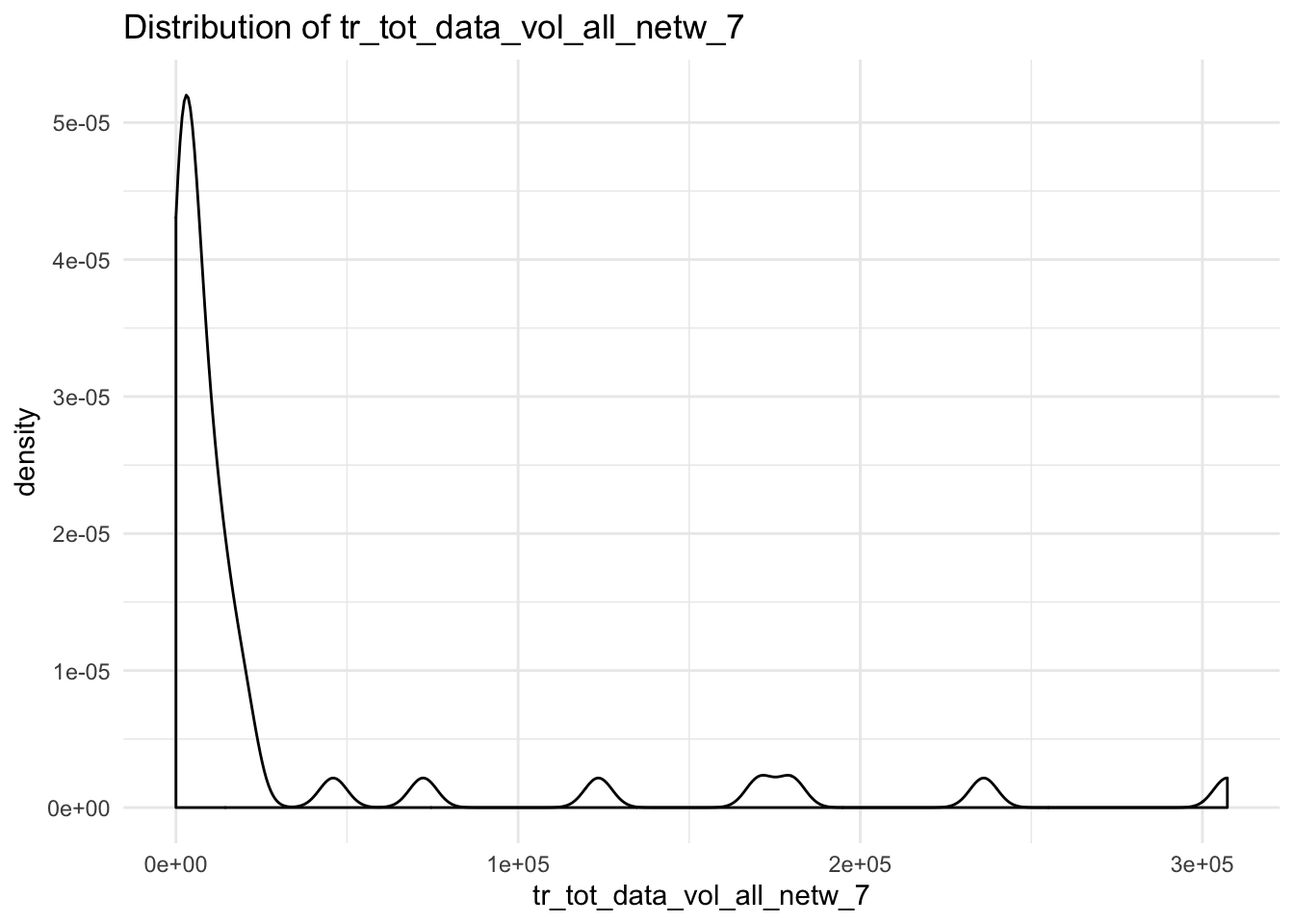
##
## $tr_tot_data_vol_all_netw_8## Warning: Removed 4 rows containing non-finite values (stat_density).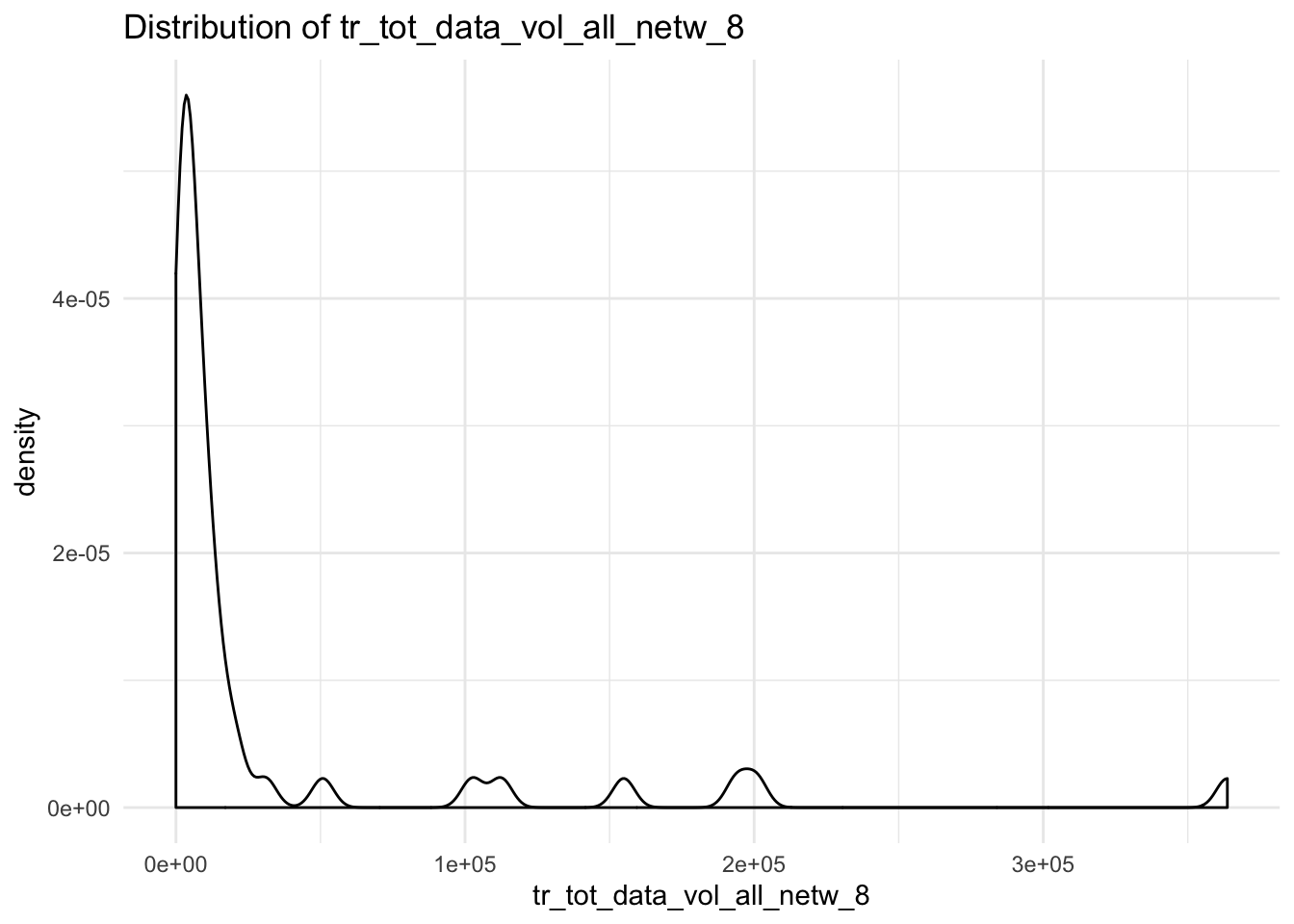
##
## $tr_tot_data_vol_all_netw_9## Warning: Removed 4 rows containing non-finite values (stat_density).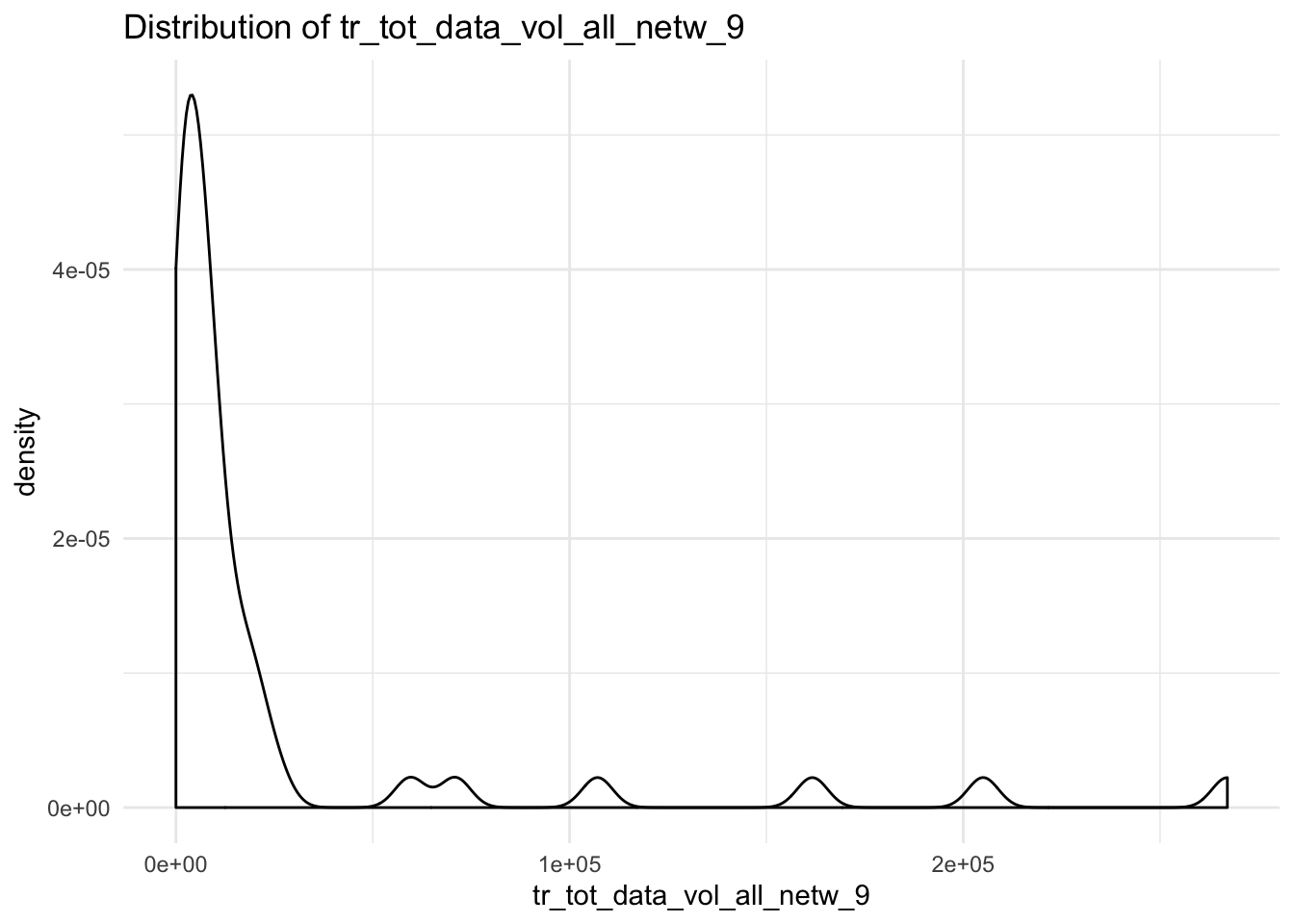
##
## $tr_tot_data_vol_all_netw_10## Warning: Removed 4 rows containing non-finite values (stat_density).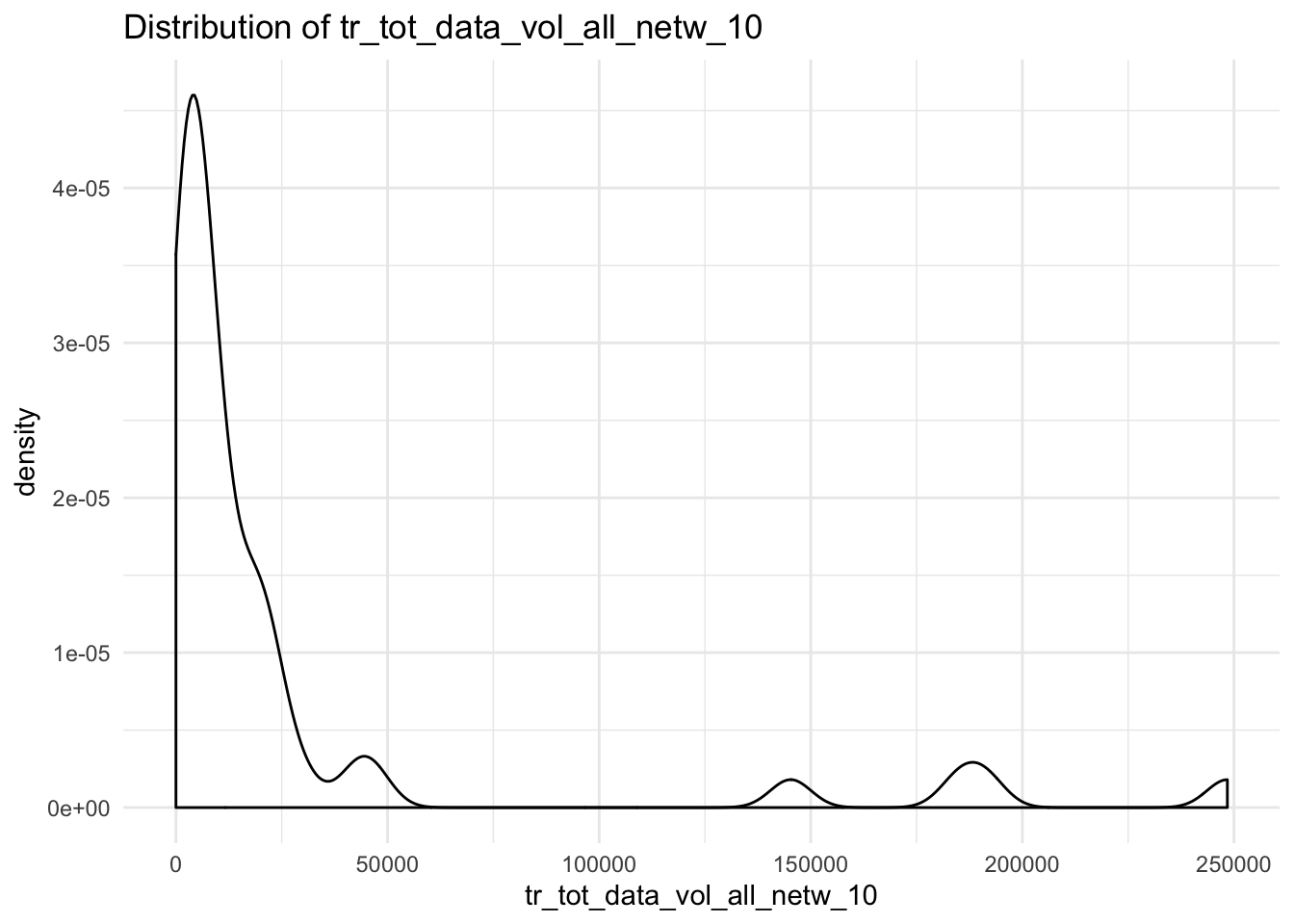
##
## $tr_tot_data_vol_all_netw_11## Warning: Removed 4 rows containing non-finite values (stat_density).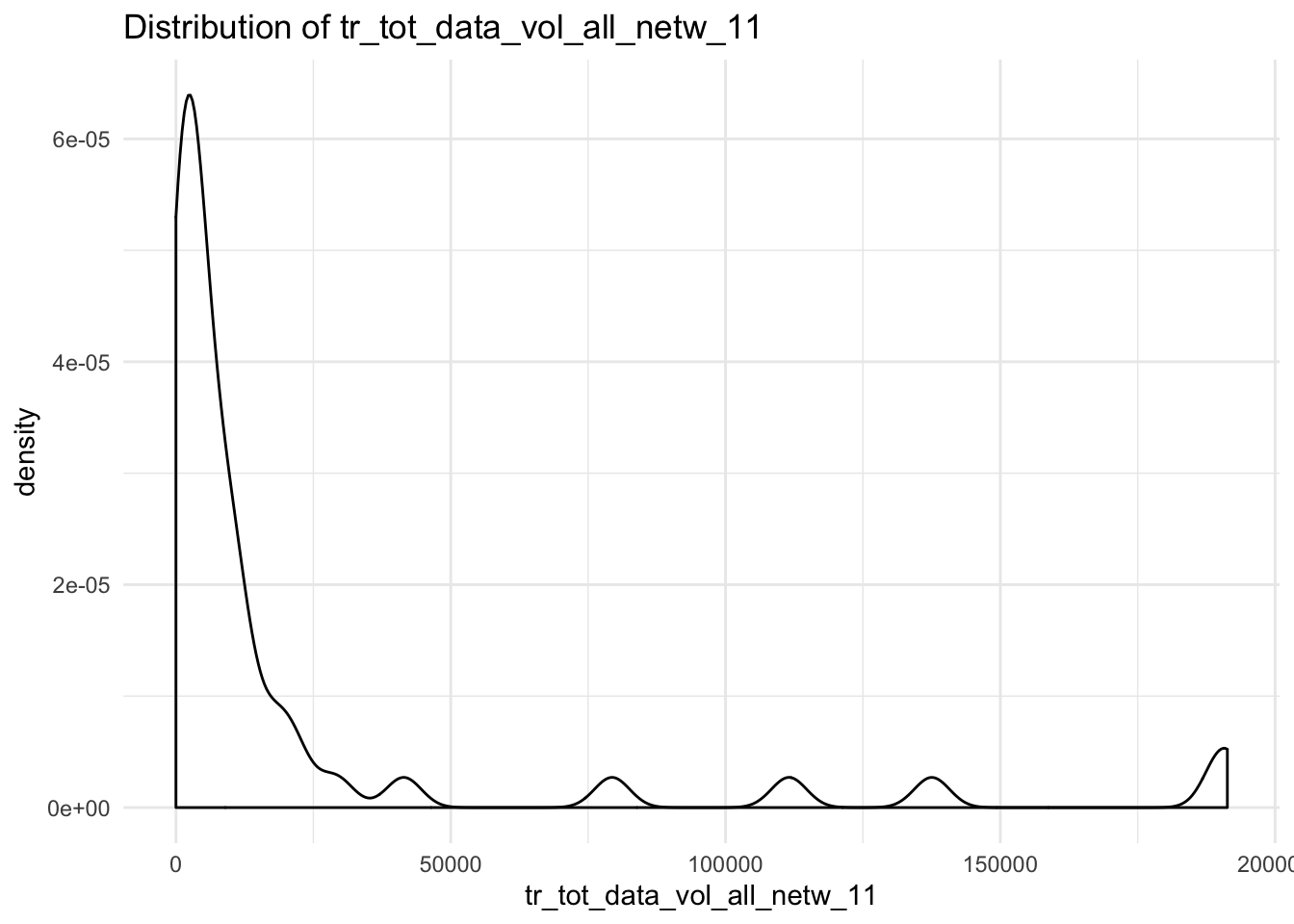
##
## $tr_tot_data_vol_all_netw_12## Warning: Removed 5 rows containing non-finite values (stat_density).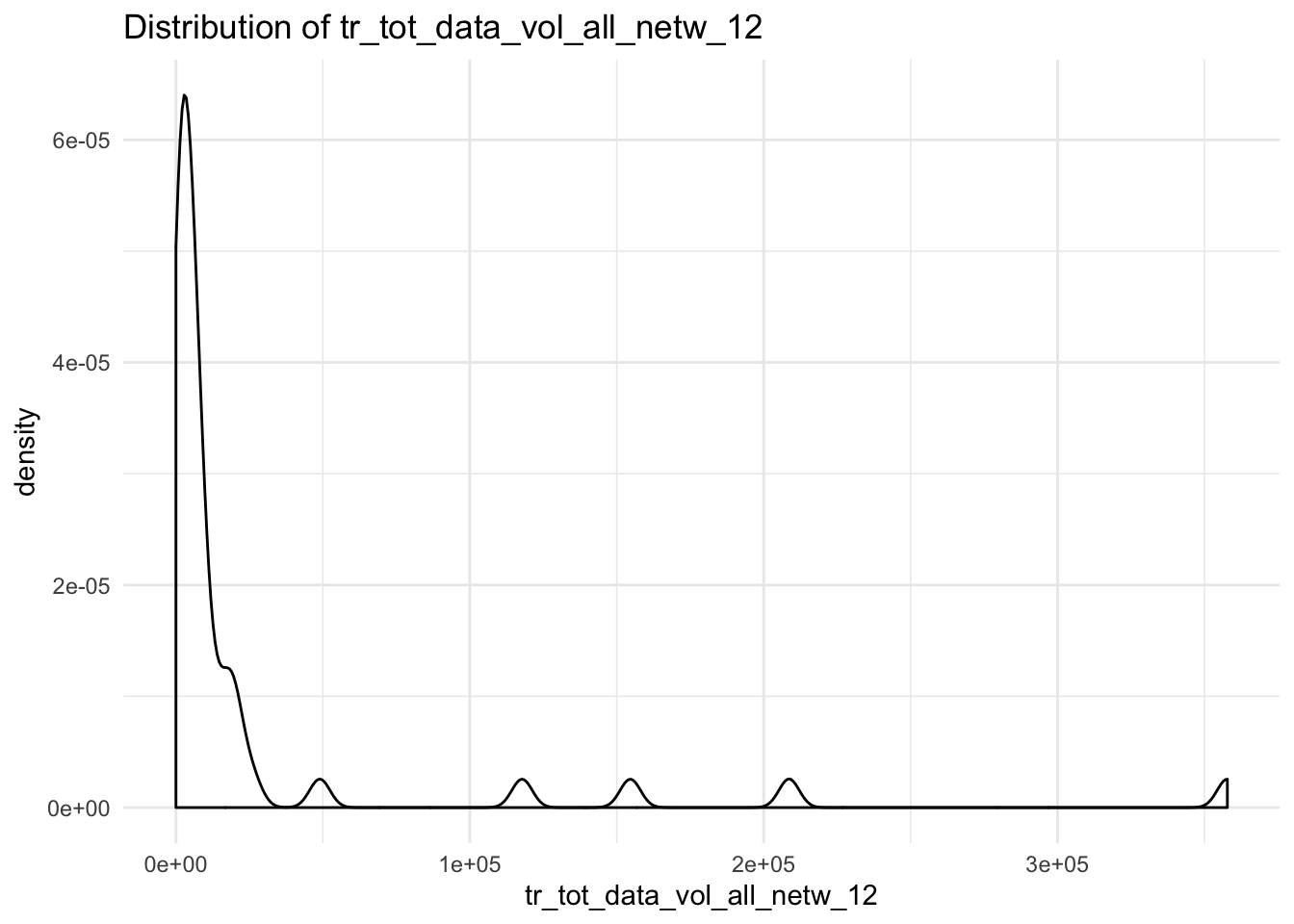
7.32.6 Excercise 4
- Using this function:
data_vol_plot <- function(x){
if(!dir.exists("plots")){
dir.create("plots")
}
p <- ggplot(df, aes_string(x = x)) +
geom_density() +
theme_minimal() +
labs(title = paste("Distribution of", x))
ggsave(paste0("plots/", x, ".png"), p)
}- Save all the plots in a folder called
plotsusing the manipulated function
7.32.7 Excercise 5
- Calculate the mean and standard deviation on every numeric column in your data frame.
df %>%
summarise_if(is.numeric, list(~mean(., na.rm = T), ~sd(., na.rm = T))) %>%
gather(column, value)## # A tibble: 28 x 2
## column value
## <chr> <dbl>
## 1 tr_tot_data_vol_all_netw_1_mean 0.136
## 2 tr_tot_data_vol_all_netw_2_mean 0.0897
## 3 tr_tot_data_vol_all_netw_3_mean 0.0936
## 4 tr_tot_data_vol_all_netw_4_mean 30779.
## 5 tr_tot_data_vol_all_netw_5_mean 28329.
## 6 tr_tot_data_vol_all_netw_6_mean 25449.
## 7 tr_tot_data_vol_all_netw_7_mean 30058.
## 8 tr_tot_data_vol_all_netw_8_mean 31373.
## 9 tr_tot_data_vol_all_netw_9_mean 25142.
## 10 tr_tot_data_vol_all_netw_10_mean 25794.
## # … with 18 more rows7.32.8 Excercise 6
- Create a local spark connection
- read the data-set
tele2-transaction.csvinto Spark usingspark_read_csv()
## Re-using existing Spark connection to local## # Source: spark<transactions> [?? x 11]
## su_contract_dt ar_key cust_id false_gi increasednosub
## <dttm> <chr> <chr> <int> <int>
## 1 2017-10-31 23:00:00 AAEBf… AAEBft… 0 1
## 2 2019-02-16 23:00:00 AAEBf… AAEBfp… 0 1
## 3 2017-07-17 22:00:00 AAEBf… AAEBfp… 0 1
## 4 2018-02-12 23:00:00 AAEBf… AAEBfn… 0 1
## 5 2018-05-01 22:00:00 AAEBf… AAEBfm… 0 1
## 6 2018-11-26 23:00:00 AAEBf… AAEBft… 0 1
## 7 2018-07-30 22:00:00 AAEBf… AAEBfk… 0 1
## 8 2017-11-05 23:00:00 AAEBf… AAEBfq… 0 1
## 9 2017-12-19 23:00:00 AAEBf… AAEBfo… 0 0
## 10 2019-03-13 23:00:00 AAEBf… AAEBft… 0 1
## # … with more rows, and 6 more variables: pc_l3_pd_spec_nm <chr>,
## # cust_tp <chr>, sc_l5_sales_cnl <chr>, pc_priceplan_nm <chr>,
## # bas_buck_size <chr>, rrpu <dbl>- Which is the most common “säljkanal”?
## # Source: spark<?> [?? x 2]
## # Groups: sc_l5_sales_cnl
## # Ordered by: desc(n)
## sc_l5_sales_cnl n
## <chr> <dbl>
## 1 CUST_CARE 170089
## 2 PARTNER_SALES 44612
## 3 CO_SALES 24190
## 4 OWN_STORES 18442
## 5 DIRECT_SALES 7185
## 6 RETAILER 6325
## 7 TELEMARKET 4388
## 8 INTERNET_STORE 3289
## 9 MISC 715
## 10 TELESALES1 601
## # … with more rows- What’s the mean
rrpufor each priceplan?
trans %>%
group_by(pc_priceplan_nm) %>%
summarise(mean_rrpu = mean(rrpu, na.rm = T)) %>%
arrange(-mean_rrpu)## # Source: spark<?> [?? x 2]
## # Ordered by: -mean_rrpu
## pc_priceplan_nm mean_rrpu
## <chr> <dbl>
## 1 Tele2 Myndighet f Tillg Medier 2285.
## 2 Tele2 Husqvarna AB Large 1280.
## 3 Låg Utland 1102.
## 4 Mobil XL 627.
## 5 Fast pris Norden 100 GB 604.
## 6 MBB 500 GB 584.
## 7 Affärspaket Large 581.
## 8 Fast Pris Norden 100GB 581.
## 9 Fast Pris Norden 50GB 551.
## 10 Fast pris Norden 50 GB 551.
## # … with more rows- How many customers did increase their number of subscriptions when signing a new contract?
## # Source: spark<?> [?? x 2]
## # Groups: increasednosub
## increasednosub n
## <int> <dbl>
## 1 1 230084
## 2 0 51557- What is the most common
bas_bucket_size?
## # Source: spark<?> [?? x 2]
## # Groups: bas_buck_size
## # Ordered by: desc(n)
## bas_buck_size n
## <chr> <dbl>
## 1 1 48950
## 2 7 45117
## 3 5 26096
## 4 0 26023
## 5 10 23922
## 6 50 13938
## 7 Unlimited 13181
## 8 30 12490
## 9 3 12451
## 10 15 11582
## # … with more rows´ ### Excercise 6
- Visualize subscriptions over time, either by day, or month or any other variable you find suitable
trans %>%
mutate(date = as.Date(su_contract_dt)) %>%
group_by(date) %>%
summarise(count = n()) %>%
collect() %>%
ungroup() %>%
mutate(month = lubridate::floor_date(date, "months")) %>%
group_by(month) %>%
summarise(count = sum(count)) %>%
ggplot(aes(x = month, y = count)) +
geom_line()## Warning: Removed 1 rows containing missing values (geom_path).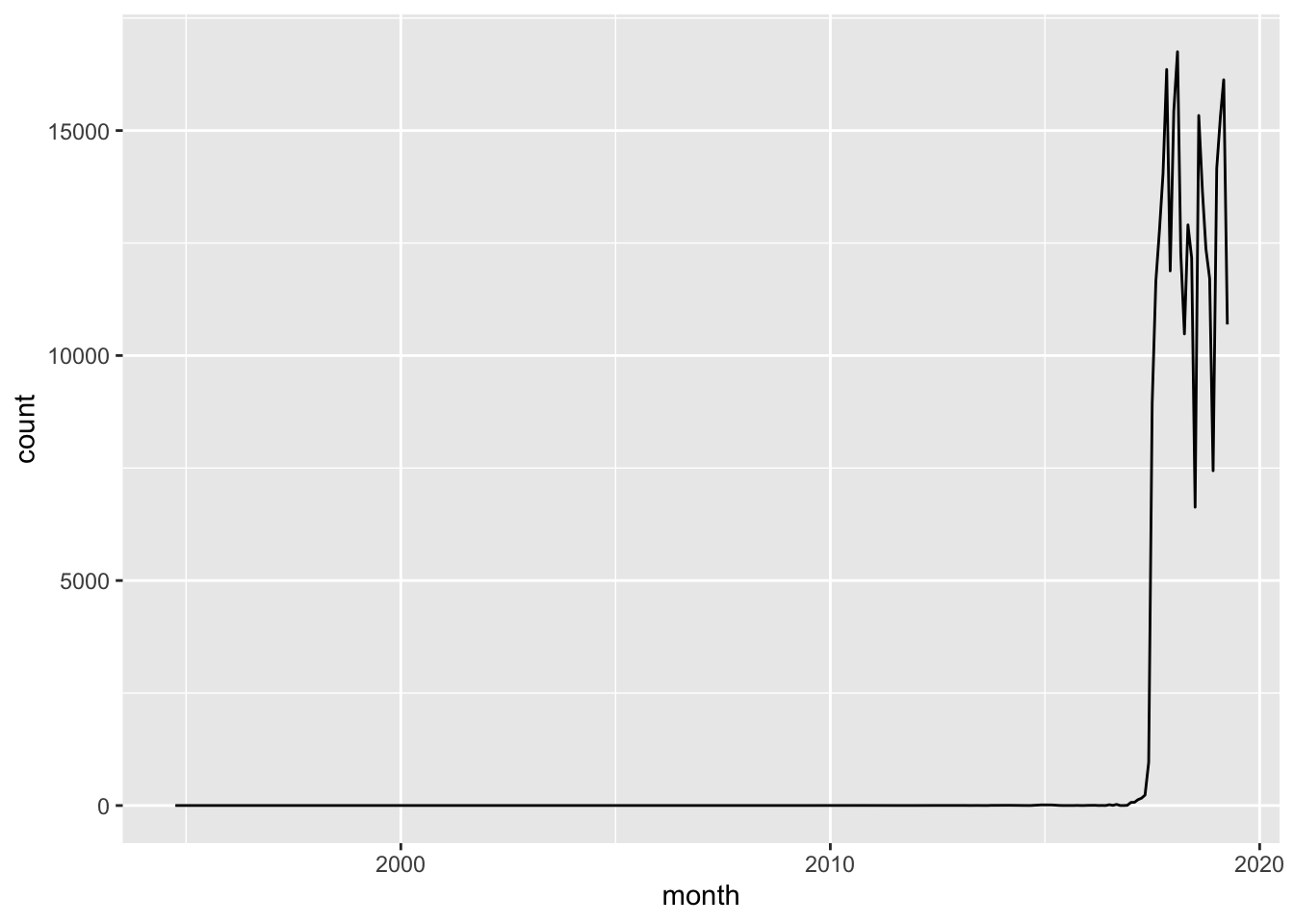
- Which top 10 priceplans are most profitable? Visualize (you can use dplyr function
top_n()to get the top 10 of a data.frame)
trans %>%
group_by(pc_priceplan_nm) %>%
summarise(mean_rrpu = mean(rrpu, na.rm = T)) %>%
collect() %>%
top_n(10) %>%
ggplot(aes(reorder(pc_priceplan_nm, mean_rrpu), y = mean_rrpu)) +
geom_col() +
coord_flip()## Selecting by mean_rrpu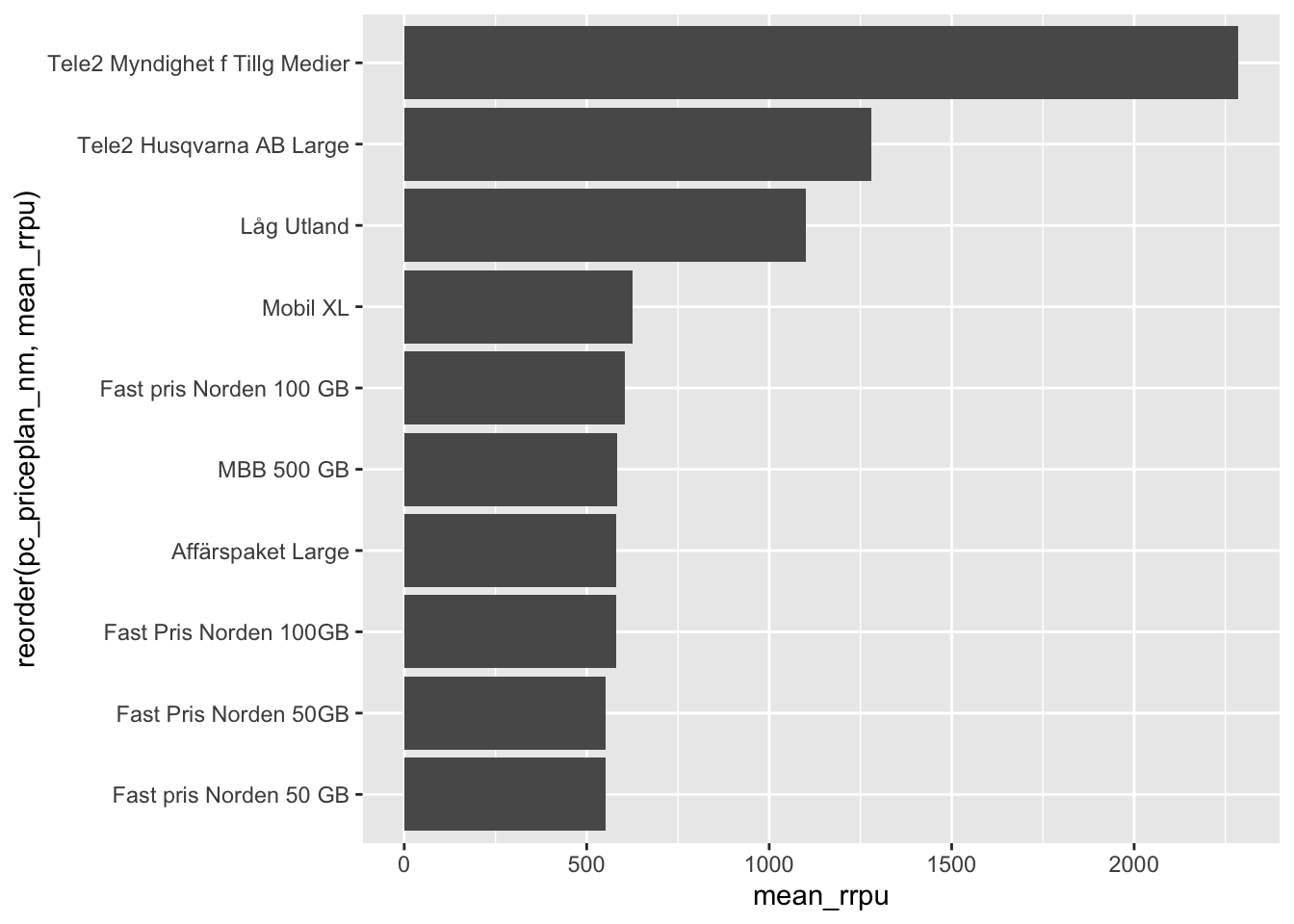
- What is the most common customer type? Visualize
trans %>%
group_by(cust_tp) %>%
count() %>%
collect() %>%
ggplot(aes(x = reorder(cust_tp, n), y = n)) +
geom_col()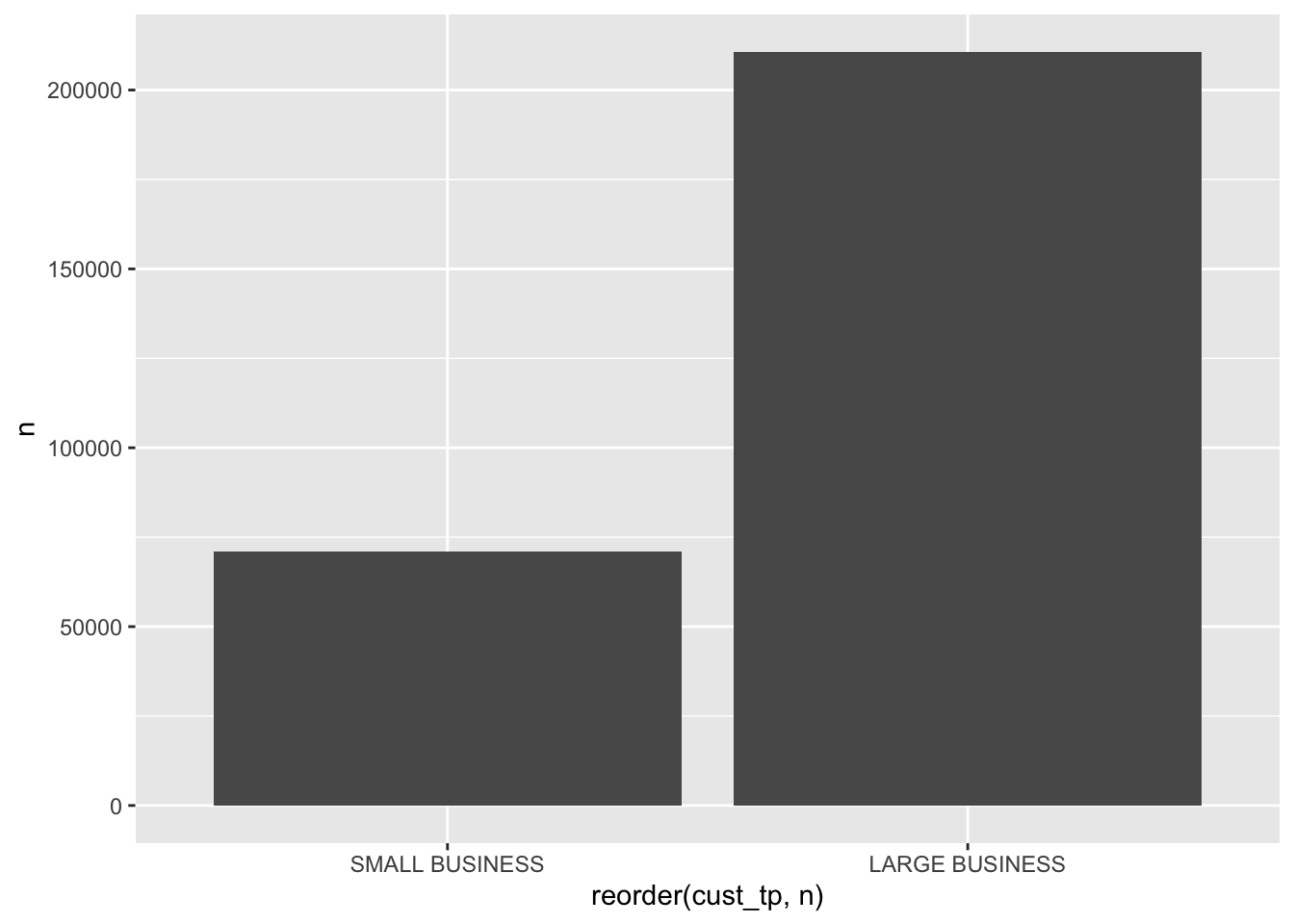
- Visualie the distribution of rrpu, use
dbplot
